OUR REGION IS AT THE CENTER OF FARMING'S FUTURE





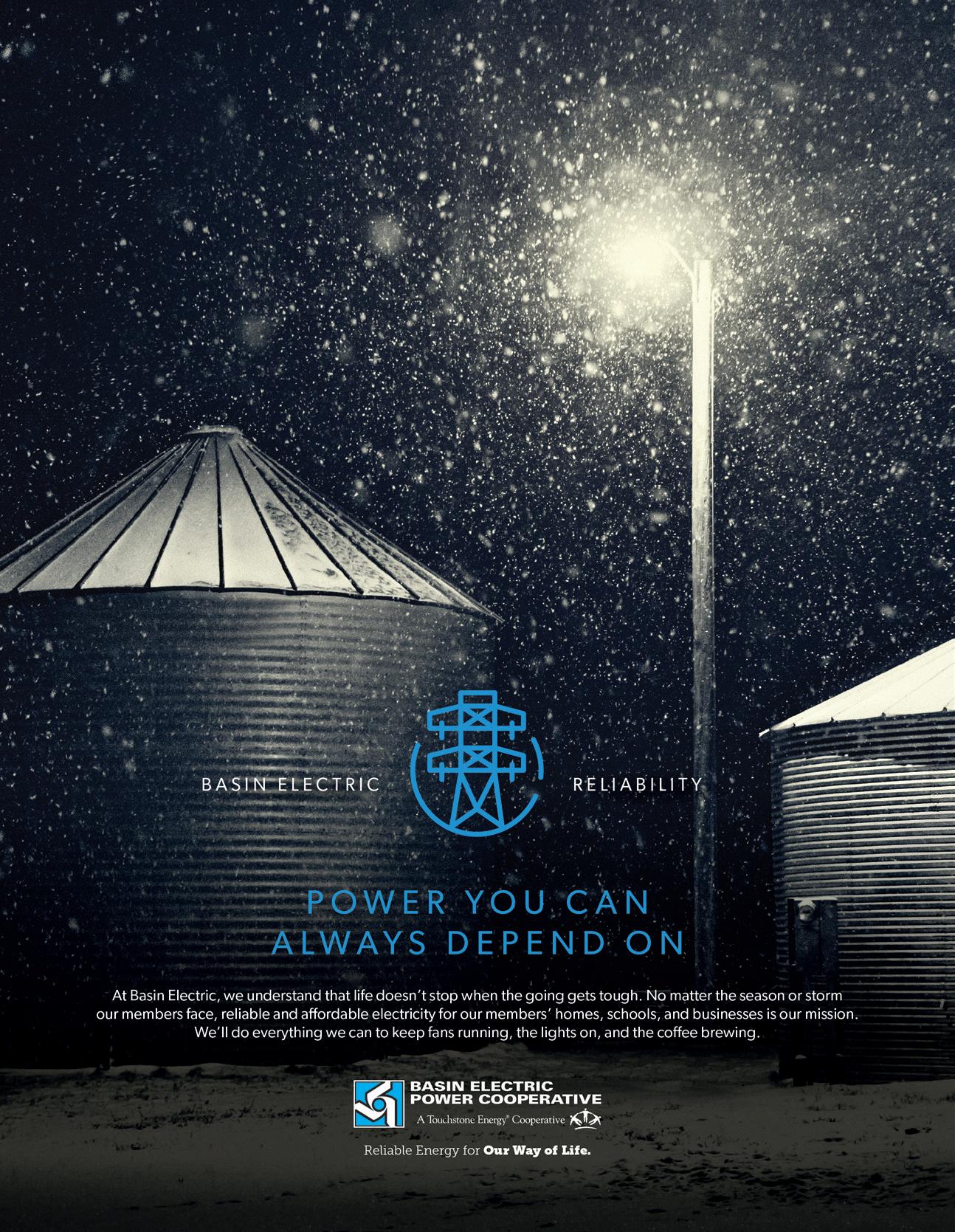

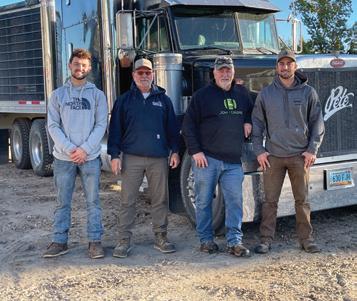
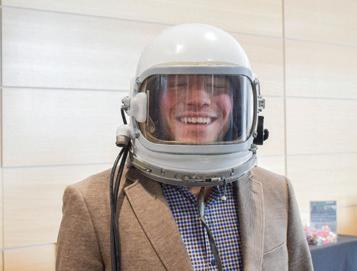
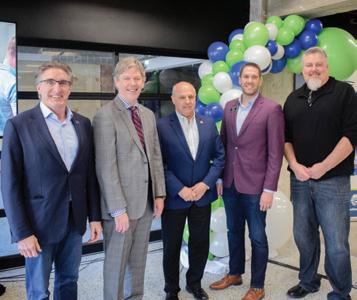
CONTENTS COVER STORY FEATURING EMERGING PRAIRIE LIKE OUR CONTENT? Check out our website at futurefarmermag.com 44 53 10 FROM FARM TO FAR OUT AND MORE... ENGAGING INNOVATORS 50 51 GRAND FARM ANNOUNCES 2023 PROGRAM AND EVENT SCHEDULE IM ALL EARS (OF CORN) 24 32 GROW YOUR NETWORK & CULTIVATE YOUR EDUCATION LOOKING TO MAKE RUNNING YOUR FARM EASIER? TRY THESE APPS! FARMER FEATURE: BILL MONGEON NDSU AG DEPARTMENT BOOK RECCOMENDATIONS 40 44 45 4 JAN/FEB 2023




Future Farmer is published 6 times a year and is direct mailed to farmers throughout North Dakota and Minnesota. Find us online at Futurefarmermag.com. Future Farmer is published by Spotlight LLC, Copyright 2023 Future Farmer. All rights reserved. No parts of this magazine may be reproduced or distributed without written permission of Future Farmer, and Spotlight LLC, is not responsible for, and expressly disclaims all liability for, damages of any kind arising out of use, reference to or reliance on such information. Spotlight LLC, accepts no liability for the accuracy of statements made by the advertisers. January/February 2023 Volume 4 Issue 1 Spotlight LLC 4609 33rd Ave S Suite #304 Fargo, ND 58104 Info@SpotlightMediaFargo.com ADVERTISING: 701-478-SPOT (7768) Publisher EDITORIAL Editorial Team Lead Editors Art Director Editorial Graphic Designers Creative Strategist Contract Content Specialist Contributors INTERACTIVE Business Development Manager Business Development Associate Videographers Director of Digital Advertising Results Graphic Designer Web Designer Social Media Specialist ADVERTISING VP of Business Development Sales Representatives Sales & Marketing Advisor Marketing Associate Client Relations Client Relations Manager Marketing Coordinator ADMINISTRATION Operations Assistant DISTRIBUTION Delivery Mike Dragosavich Brady Drake FargoInc@SpotlightMediaFargo.com Geneva Nodland, Grant Ayers, Sam Kise Kim Cowles Levi Dinh, Ty Betts Josiah Kopp Gary Ussery Emerging Prairie Nick Schommer Kellen Feeney Tommy Uhlir Jonathan Chicka Ben Buchanan Kellan
Ryne
Hoefer Paul@SpotlightMediaFargo.com
Benson
Bigelow Paul
Al Anderson Al@SpotlightMediaFargo.com Devan Maki Devan@SpotlightMediaFargo.com Tori Helland Tori@SpotlightMediaFargo.com
ClientRelations@SpotlightMediaFargo.com
Kacey Mongeon Kacey@SpotlightMediaFargo.com Hailey Bebler Hailey@SpotlightMediaFargo.com
Farmer
Jenny Johnson Jessica Mullen Miranda Knudson John Stuber Future


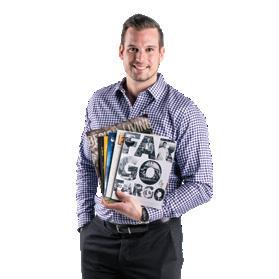
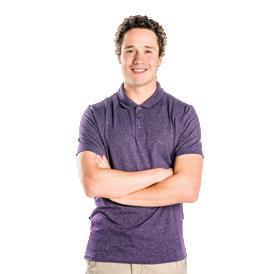
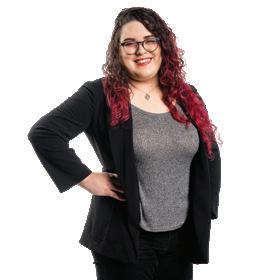



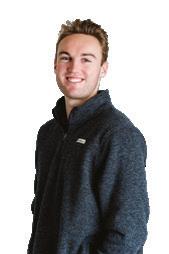




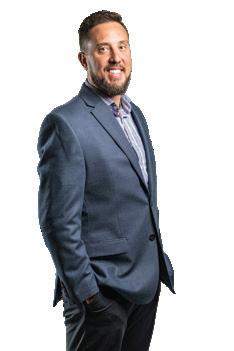


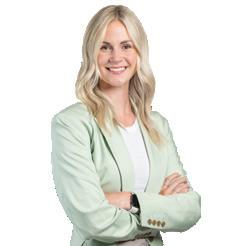

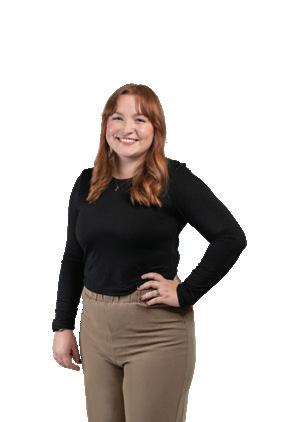


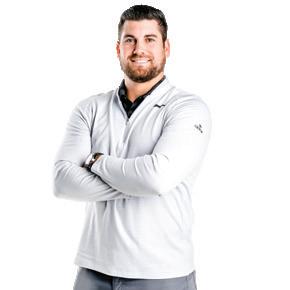





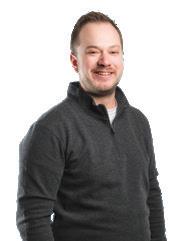
 MIKE BRADY KIM
LEVI TY
GENEVA
GRANT
SAM JOSIAH
GARY
PAUL
DEVAN TORI
KACEY HAILEY
MIRANDA
JESSICA
NICK KELLEN
BEN TOMMY KELLAN
JONATHAN
MIKE BRADY KIM
LEVI TY
GENEVA
GRANT
SAM JOSIAH
GARY
PAUL
DEVAN TORI
KACEY HAILEY
MIRANDA
JESSICA
NICK KELLEN
BEN TOMMY KELLAN
JONATHAN
Learn more about us at spotlightmediafargo.com
RYNE JOHN
8 JAN/FEB 2023
Meet The Team

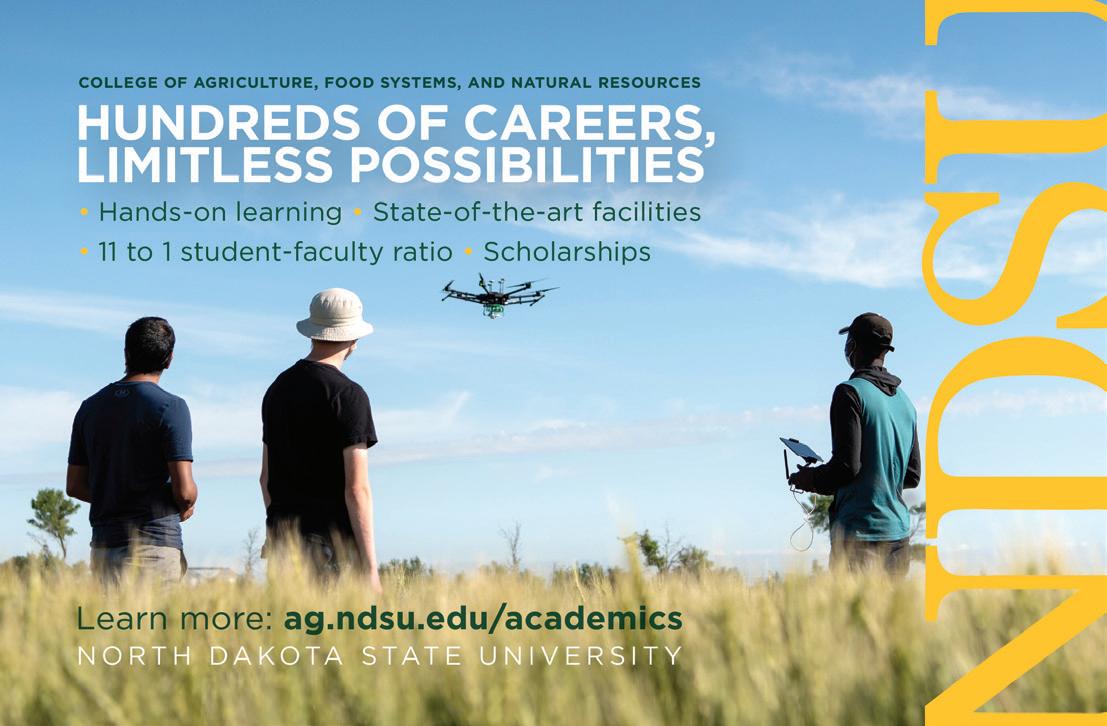 BY GARY USSERY
BY GARY USSERY

10 JAN/FEB 2023
We as people have often found dinnertime to be key in our day to day—not only for eating, but for sharing, whether it be stories around the fire or a retelling of our day around the dinner table. Mealtime is important because it is when we let our guard down and revel in the company of others.


With this in mind, what does the future hold for mealtime? Particularly, what does an earth-free mealtime look like? Prepackaged foods have long been the solution for space travel, and why shouldn’t they be? They are sterile, light weight, packed with necessary nutrients and they often require little more than the package they came in to be prepared. However, prepackaged meals can only get you so far. An expedition to Mars could be years long. How do we feed our astronauts then? What about if we colonize another terrestrial body? Do we maintain the current methods and simply send a rocket into space every few months to deliver the nutrients necessary for life?
These questions are exactly what the Space Ag Conference hosted by Grand Farm seeks to answer while also getting young people and farmers alike interested in the intersection between space and agriculture.
FUTUREFARMERMAG.COM 11
The Space Ag Conference aims to tackle the tech behind the future of agriculture in space with the knowledge that advancements in space-based farming will also have the potential to apply to similar challenges on earth.
Agriculture in space must be sustainable and secure, which would, of course, be beneficial to agriculture on Earth.
The goals of the conference include:

Encouraging the next generation of innovators to dream.
Exploring agricultural possibilities through the lens of space.

Showcasing the challenges of space agriculture.
Speeding up collaboration and innovation.
Highlighting cooperation with NASA and space industry leaders.
The Space Ag Conference was inspired by the Grand Farm’s connection with Ralph Fritsche, NASA’s Senior Project Manager for
Space Crop Production and Exploration Food Systems in support of Deep Space Exploration. Fritsche discussed topics like the impact of space technology in regards to terrestrial agriculture as well as the history of using satellites to track and measure crop yields and health.
Since its conception in 2021, the goal of the Space Ag Conference has been to attract high school and college students into the field of agriculture. While farms are getting bigger and more complex, fewer and fewer students are exposed to agriculture professions. We need new people entering agriculture. The Space Ag Conference aims to entice a new generation of future farmers.
You can expect a prolific panel of guest speakers at this year’s Space Ag Conference.
There have been a number of notable speakers to grace Grand Farm's Space Ag conference stage.
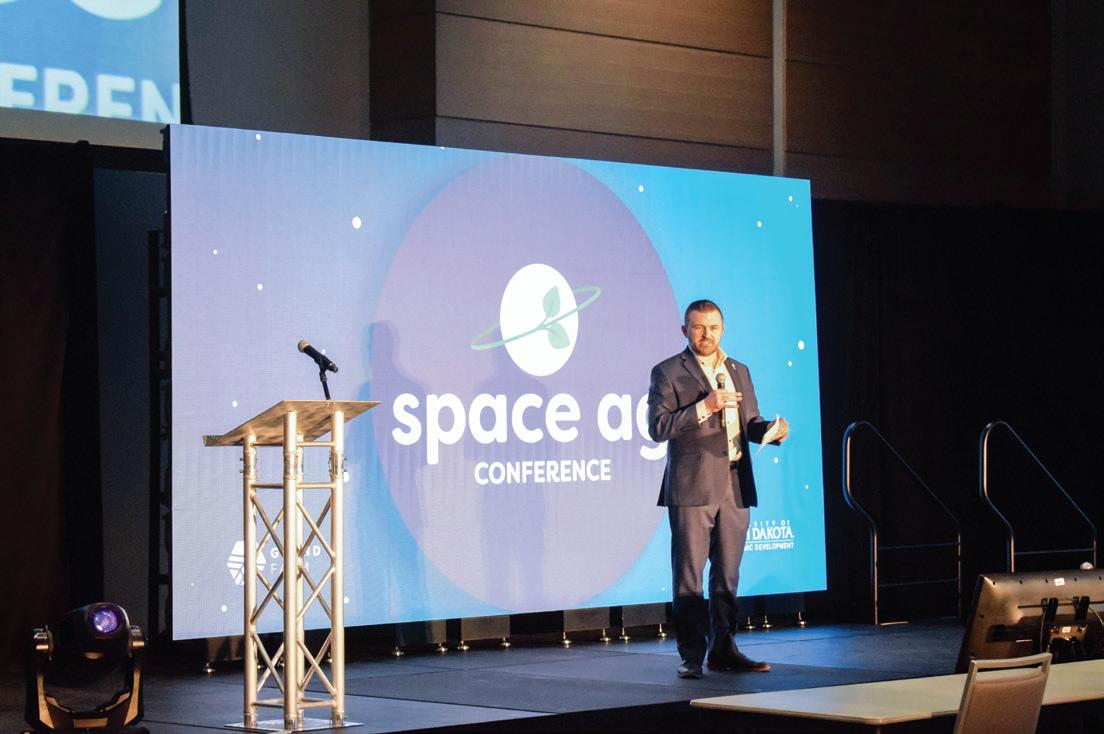 Photos provided by Emerging Prairie
Photos provided by Emerging Prairie
12 JAN/FEB 2023
INSPIRING YOUNG MINDS
With one of the main undertakings of the Space Ag Conference being to attract and inspire students, this year’s conference offers many educational opportunities for those interested in agriculture, space and the worlds beyond!
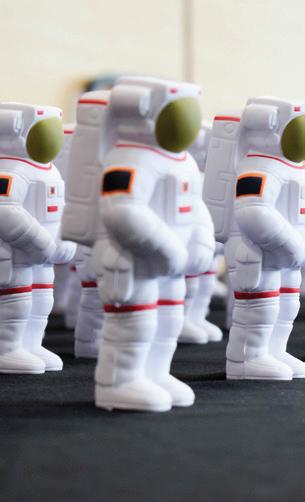
University Of North Dakota: Near-Space Mission


High school students can join the University of North Dakota as they send seeds into low Earth orbit. This weatherdependent event will allow participants to view the launch of a high-altitude balloon that climbs into the stratosphere with a payload of seeds. The balloons will approach the edge of space and if they can be recovered rapidly, the students will return the same day with seeds that traveled to a near-space environment and back to earth.
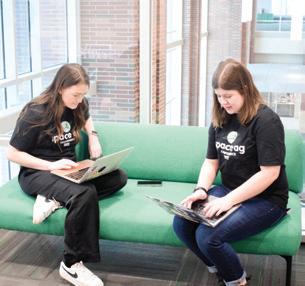
North Dakota State University: Plant The Moon
Students will receive a brief explanation about the roles of microbes and how they help crops grow in space. Microbes can help us increase our nutrients while also reducing the payload of bringing fertilizers to space.
Students will then work in groups collecting data for the experiment wherein crops, likely peas, do not receive a microbial treatment. Students will collect data regarding plant growth and assess formation of root nodules and chlorophyll content of the plants to determine if the microbes did their job and improved crop growth in the lunar regolith.
With this design, NDSU’s Plant the Moon teams received Best in Show awards for Innovation and Experimental Design in 2022 and for Best Crop Growth in 2023.
NATIONAL CENTER FOR AUTONOMOUS TECHNOLOGY (NCAT): FLYING DRONES
Activity: A small experimental station on mars needs re-supply!

A team of students will train to fly across the harsh Mars surface to give critical items to another team doing valuable research. In this training mission, student teams will create valuable operating protocols to navigate low-visibility situations and hone their skills to fly the drone completely autonomously if the weather deteriorates further. Students will work together to fly a DJI Tello drone through an obstacle course to reach a destination. They will have the opportunity to fly both by line-ofsight and autonomously with Scratch, a simple program that allows you to script autonomous flight.
TrainND Northwest: Drones and Simulators
Students will learn about the possibilities that exist with drones. Experts from TrainND will discuss the pathway to commercial drone use. Students will then get to experience flying a drone using the simulator. TrainND will have multiple drones of different sizes on display and students will get a diverse perspective on drone application in different industries.
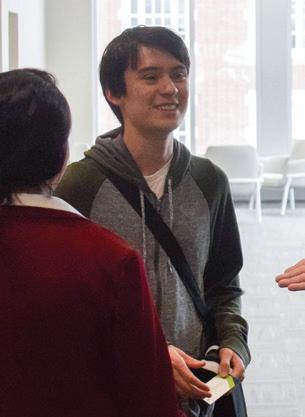
FUTUREFARMERMAG.COM 13
SHERRY FIEBER-BEYER KRIS KIMEL
Kris Kimel is the founder of Humanity in Deep Space. Last year he spoke about Interplanetary Agriculture.

"As our species transitions into deep space, one of the hardest problems will be producing food and a diverse diet to allow humans not to just survive but thrive in space," Kimel said. "We are already a spacefaring civilization and off-planet experiences and habitation is now part of our near future."
Sherry Fieber-Beyer is the assistant professor of Space Studies for UND. She was invited to speak at last year's conference because of her research currently investigating the growth potential of asteroid soil simulant to grow crops in space.
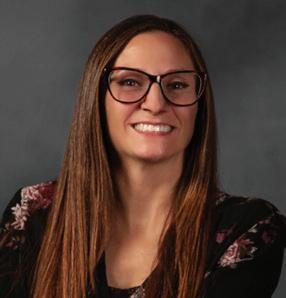
She believes that growers are the backbone of any society and their involvement will be necessary for our long-term survival in space.
One of Fieber-Beyer's key speaking points is one not often talked about: the earth's soil health.
"At some point, Earth's soil will no longer be able to support plant life... before that happens, we do have an opportunity to mine carbonaceous asteroids for their rich regolith and replenish Earth's top soils by direct regolith transfer or possibly through hydroponic solutions,” Fieber-Beyer said.


14 JAN/FEB 2023
Photos provided by Emerging Prairie
ASHLEY KORZUN AEROSPACE ENGINEER, NASA
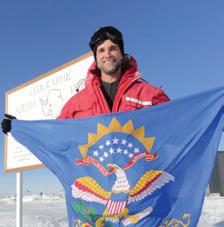
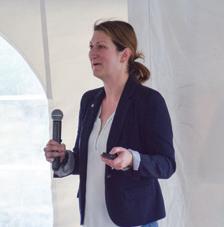
The National Aeronautics and Space Administration (NASA) is America’s space exploration leader. With over 312,000 employees spread over 20 facilities planetside, an important distinction when talking about NASA is that they lead the pack in fields of research such as climate, our solar system and worlds beyond.
JOHN RASK DIRECTOR OF ASTROBIOLOGY OPERATIONS, OFFICE OF THE CENTER DIRECTOR, NASA AMES RESEARCH CENTER
The Ames Research Center, founded in 1939, is located in California’s silicon valley. Their research primarily focuses on keeping America’s skies safe in the age of aircraft, commercial drones and, one day, flying cars.
DR. GARY STUTTE PRESIDENT, SYNRGE, LLC.
SyNRGE exists to bridge the gap between feeding people in space and those on Earth. They use research and developing technology to feed a small population on Mars to find innovative ways to feed the eight billion people back home on Earth.
LANNY FALEIDE PRESIDENT AND FOUNDER, SATSHOT
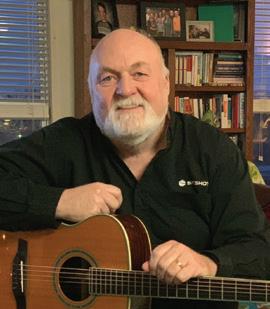
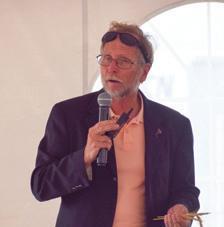
Established in 1994, Satshot has become a leader in remote sensing. Larger crop yields while saving money on chemicals, seed and fertilizer are the major attributions of Satshot. Satshot acquires billions of acres worth of imagery every growing season, and that information can be distributed to any corner of the world.

 Photos provided by Emerging Prairie
Photos provided by Emerging Prairie
FUTUREFARMERMAG.COM 15
MICHELLE LUCAS FOUNDER AND PRESIDENT, HIGHER ORBITS FOUNDATION
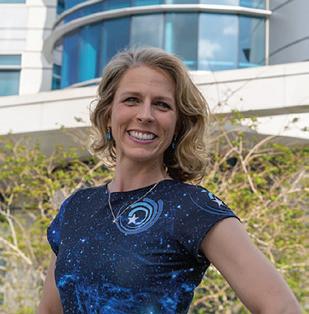
Higher Orbits' primary mission is to bring curious high-school students into the fields of science, technology, engineering, arts and math (STEAM).

PABLO DE LEÓN
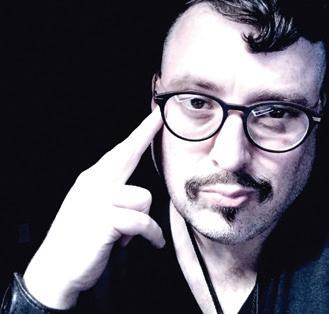

PROFESSOR AND CHAIR, DEPARTMENT OF SPACE STUDIES AT THE UNIVERSITY OF NORTH DAKOTA
Our very own UND has a long-standing relationship with NASA. UND is the first university to have a NASA-funded lab dedicated to designing space exploration and planetary exploration suits. UND earned a NASA-Johnson Space Center (JSC) appreciation award in 2013.
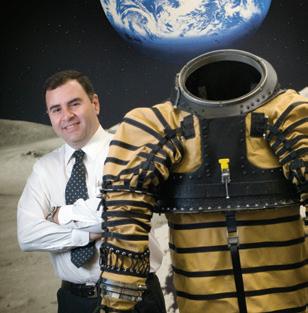
LEO BARTON WOMACK FOUNDER AND CEO, EDEN GROW SYSTEMS
Eden Grow Systems is putting technology to work in an effort to bring food security to everyone. Using new technology like aeroponics and automation, they inspire to produce more from less work.
CONTINUED
16 JAN/FEB 2023
VICE PRESIDENT AND CBO, SPACE LAB TECHNOLOGIES
Space Lab brings their insight into habitation to the table. Space agriculture, water recovery, thermal control and air revitalization are some of their specialties.
BREANNA PASTIR
AGRICULTURE TEACHER, SOUTHEASTERN REGION CAREER AND TECHNOLOGY CENTER
Southeastern Region Career and Technology Center is a co-op that offers classes and educational experiences that may supplement current curriculums and is located in Wahpeton, ND.
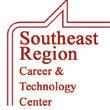
RALPH FRITSCHE
SENIOR PROJECT MANAGER FOR SPACE CROP PRODUCTION IN SUPPORT OF DEEP SPACE EXPLORATION, NASA




CHRISTINE ESCOBAR JINSEONG KIM
We have an in-depth interview with Fritsche you can find on page 18.
MIKE VINJE
CENTER TECHNOLOGY TRANSITION LEAD, NASA SBIR/STTR

Small Business Innovation Research (SBIR) and Small Business Technology Transfer (STTR) are both programs developed to help small businesses fund the important research and technology that fulfill NASA’s needs.
SR. RESEARCH SCIENTIST, LYNNTECH

Lynntech was launched in 1987. Lynntech’s scientists and engineers work together to execute all stages of technology from exploratory research to advanced fabrication and software integration.
MARION LITZINGER GROWING BEYOND EARTH
Growing Beyond Earth (GBE) is a NASA partnered program designed to advance research into growing plants in space. GBE is a classroom, citizen-based science project.

ADAM WILLIAMS
UNIVERSITY OF MINNESOTA
The University of Minnesota is home to the School of Physics and Astronomy. With coursework in classical mechanics, electricity and magnetism, quantum physics and thermal/statistical physics, the University of Minnesota affords a new generation the ability to become involved with cutting edge contemporary research.

FUTUREFARMERMAG.COM 17
If you’ve heard about autonomous farms in recent news, Grand Farm of Emerging Prairie was most likely the name behind it.
Tasking themselves with building the “farm of the future,” the people behind Grand Farm have set out to capitalize on the region’s expertise in both the agriculture and technology industries.
Grand Farm has been backed by North Dakota’s own Governor Doug Burgum who, in 2019, announced that Grand Farm would receive a $10 million matching grant from the department of commerce. “It’s an investment that will further accelerate ag innovation, and it’s going to have a transformative impact on the future of North Dakota and our nation’s agriculture,” Burgum said.

Grand Farm’s primary goal is to encourage collaboration among businesses, organizations and researchers.

A Q&A WITH RALPH FRITSCHE
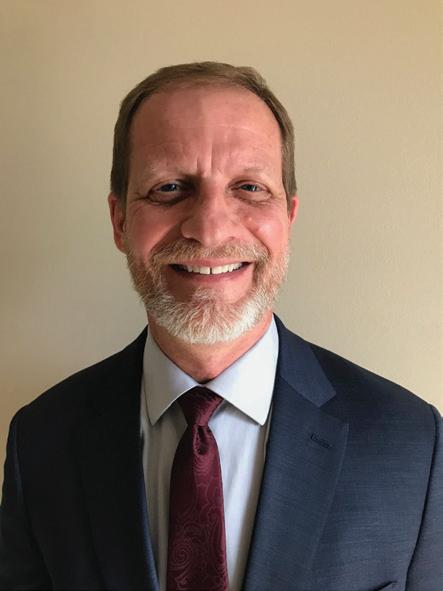


developing sustainable and reliable fresh food systems. His work focuses primarily on supporting long duration space missions beyond low Earth orbit (LEO). Fritsche began his career with NASA in 1989 and has supported the US Manned Space Program in various engineering and operational roles. He also received the NASA Exceptional Service Medal.
 Photos provided by NASA
Photos provided by NASA
18 JAN/FEB 2023
WHY DID NASA THINK IT WOULD BE IMPORTANT TO BE A PARTNER IN THE SPACE AG CONFERENCE?
NASA has been involved with North Dakota for a number of years now. So, we’ve worked with the University of North Dakota, they have a Lunar-Mars greenhouse set up there that we’ve worked with them on. It’s an EPSCoR state. We also look at promoting small business. There seems to be a lot of work going on in North Dakota when it comes to such topics as robotics and automation.

IF NASA IS PRESENTING AT THE CONFERENCE THIS YEAR, CAN YOU GIVE US A PREVIEW OF WHAT MESSAGE WILL BE DELIVERED TO THE ATTENDEES?


My fundamental area of responsibility is laying the framework for exploration for food systems and specifically space crop production activities. So, we look at pick-and-eat type crops initially as part of the supplementation of that pre-packaged food that we’ve relied on since the beginning of the space program. Chronologically speaking, it’s for these long duration missions to Mars where our pre-packaged food system starts to degrade. So they’re looking to extend that, as a safety net and also as a way of adding additional flavors, textures, content and variety. So I’ll probably talk a little about our plans for that. I’ll probably give an overview going out over the next 20 or so years as to what NASA’s thoughts are for how we introduce crop production, specifically pick-and-eat type crops that require little to no processing and preparation into the architecture that we’re using for Artemis and the exploration of the moon and eventually Mars.
IN LAYMAN'S TERMS, HOW DOES NASA BENEFIT AGRICULTURE RIGHT NOW?
We are working on the areas of what kind of seeds do we take with us? How do we optimize seeds so that they are pathogen free so that it doesn't introduce problems later on with the continuous growth cycles on a space vehicle? How do we develop seeds that can handle some of the unique stresses that we have in space flight? And some of those stresses are, you know, similar to ones that would be for plants grown in fields or in a commercial controlled environment, agricultural setting. Then it's the technology. How do you monitor these things in the field? How do you reduce crew time, or in this case, labor for the areas of maintaining the crops, harvesting the crops, et cetera? So I think it’s more on the fringe of technology application that would relate to field agriculture more than anything else.
HAS AGRICULTURE BEEN SOMETHING THAT NASA HAS KEPT IN MIND FROM THE BEGINNING?
I’ve been doing a little history dig up and I actually found a copy in a September 1958 copy of “Food Technology Magazine” that predates any of our crewed space flight missions. It’s going back to the Manhigh Program where we were looking at first attempts to see how humans tolerate the upper atmosphere beyond 95%, 99% of the Earth’s atmosphere in balloon flights. And even back then, they were talking about cyanobacteria, spirulina, as being a potential source of nutrition for crews on early space flight missions. So I would say this goes hand in hand with the dawn and predawn of the space program, our interest in agriculture and space.
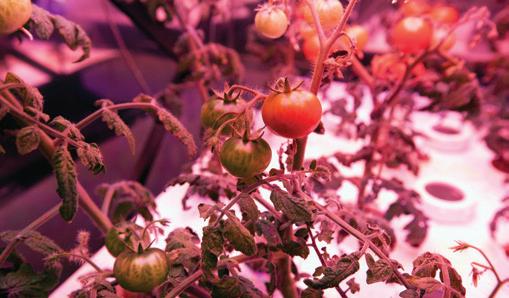
FUTUREFARMERMAG.COM 19
In the Space Life Sciences Laboratory at NASA's Kennedy Space Center in Florida, student interns are joining agency scientists to contribute in the area of plant growth research for food production in space. The agency attracts its future workforce through the NASA Internship, Fellowships and Scholarships or NIFS program.
IS THERE ANYWHERE THAT NASA IS CURRENTLY LOOKING TO COLLABORATE WITH FARMERS? ANYTHING FARMS CAN DO TO HELP?
One of the things that we look at for the future is the potential for growing crops in either lunar surface material or Mars surface material. When I talk about doing that, I’m looking at soils that are nowhere near optimized like Earth’s soils are. There are similarities there in techniques and approaches most likely that can be done to kind of rejuvenate or convert depleted, non-usable or non-efficient soils for plant growth terrestrially, and what we’re trying to do with this lunar and Mars surface simulants that we work with. So I think there will be some collaboration in those areas. We actually had an opportunity to grow some plants in some of the early Apollo samples.

SO, YOU DID JUST SAY THAT NASA WAS ABLE TO GROW VEGETATION IN SAMPLES FROM THE MOON?
Take it with a grain of salt in the sense that they use material from several different Apollo missions. They got a model plant, arabidopsis, to grow in it. Not very well because they weren’t doing anything at this point to see what they could do to improve growth. They were just trying to see if they could get growth.
ARE THERE ANY RESOURCES THAT FARMERS SHOULD KNOW ABOUT FROM NASA THAT COULD HELP THEM?
If you think of remote sensing, which is common, it started off with satellite remote sensing, then it made its way into drones. That type of technology is something that NASA has used over the years that made its way into a field agriculture setting. I think similar to machines that will be used to identify fruit and crops when they’re


ready for harvest and go pick those autonomously. A tech transfer like that from what NASA does into the terrestrial setting, they always look for a straight path. The reality is that most all of the things that NASA has done and developed that eventually have made its way into commercial applications has gone through multiple steps along the way to take a specific use for NASA and develop it, refine it and apply it through a variety of steps into something that actually makes it into a commercial setting.
WHAT ARE SOME THINGS THAT YOU AT NASA ARE CURRENTLY EXCITED ABOUT IN REGARDS TO SPACE CROPS?
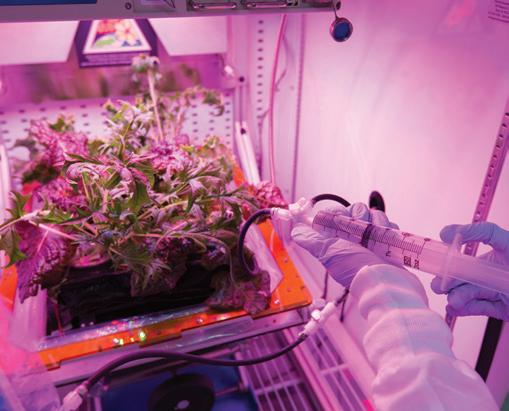
There’s a veggie system and the advanced plant habitat. We have been able to show that we could grow crop plants, plants that were edible and something the crew would consume. The crew has eaten them and that kind of proves a concept that we can grow plants not only for research, but you could grow the types of plants, the crops that we would want to eat. We’ve finally gotten another stakeholder who’s more in setting up the technologies that we would need to bring to exploration to actually fund the development of the first crop production chamber. So, this would be a chamber that is primarily designed to grow crops, plants as a source of food. We’ll know what the productivity of what you grow would be, and we’ll know about the cleaning aspects, how frequently it needs to be cleaned, where are the failure points that need to be worked on and what’s the food safety aspect.
That’s really important because that’s going to prove the concept of taking a system like this on the mission to Mars.
NASA Kennedy
Center's ISS environment
Mizuna
Outredgeous
20 JAN/FEB 2023
Water and nutrients are being added to plants in the Veggie hardware in
Space
simulator chamber.
mustard,
lettuce and Waldmann's green lettuce are growing in Veggie. Growth in the chamber mimics the growth of plant experiments in the Veggie plant growth system on the International Space Station.
The International Space Station
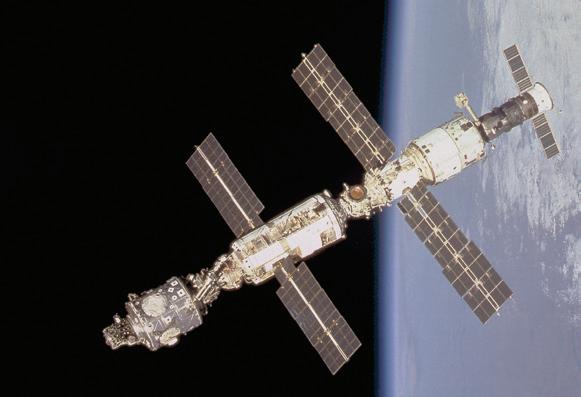
YOU’VE MENTIONED THE ENJOYABILITY OF THE FOOD, HOW DOES THAT RANK IN IMPORTANCE?

From a very practical perspective, there’s a concept called menu fatigue. If you limit the menu to a certain number of items, after a period of time, the crews are going to get tired of them. On missions a year or so long, the crews are losing weight because they just get tired of certain things. If you think about an analogy of missions to space being like the early Arctic and Antarctic exploration missions, meals were a very important period of time for them and as they are for astronauts because if you think about the isolation they’re in, in a sterile environment, they have very little left of home. A good meal provides an opportunity for the crews to get together and talk about their day.
FOR


THE MARS MISSION, WHAT DO
THE STEPS LOOK LIKE IN GETTING THE TECHNOLOGY TO THE POINT WHERE IT IS READY FOR THAT MISSION? DO YOU START ON EARTH, THEN GO TO THE INTERNATIONAL SPACE STATION, AND THEN WHAT?
You’re pretty much spot on. We do everything on the ground before we bring it up to low earth orbit. It’s always a case of you want to do as much of the work you can do in the easiest venue you have access to. The factor in it that affects everything is the fact that on the ground, we don’t have the microgravity environment.

TIME WILL TELL HOW WE WILL FEED OUR ASTRONAUTS ON TRIPS TO MARS.
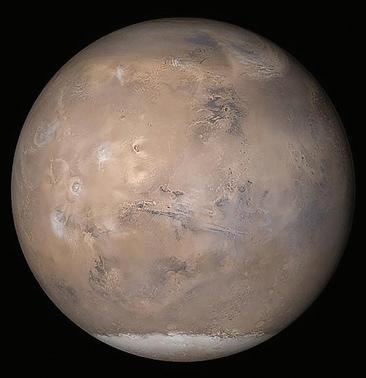
WHAT IS THE MOST GROUNDBREAKING THING THAT YOU HAVE LEARNED RECENTLY WHEN IT COMES TO SPACE CROPS AND LONG TERM SPACE TRAVEL?
Groundbreaking to me means something that’s extremely compelling and I don’t know that we have any grand “aha!” moment. I think the very fact that we know we can grow things in space is the compelling thing. That’s it.



WHAT KIND OF IMPACT DO YOU THINK THIS IS GOING TO HAVE WITH FARMING ON EARTH?
We’re all talking about the same thing and that is feeding humans nutritious, safe, healthy food, and a variety of food in challenging conditions. With climate change,

how that’s affecting different growth areas across the world, we’re all looking at the same problems. So, I think it would be hard for me to predict today how that might converge between field agriculture, controlled environment agriculture and space technology in the next 10, 20 or 30 years.
WHAT IS A MESSAGE THAT YOU PERSONALLY WOULD HAVE FOR FARMERS THAT ARE INTERESTED IN THIS TECHNOLOGY?
We in NASA, in the food area, have a deep respect for everything that they do. We recognize that by the year 2050, we’re looking at trying to feed maybe a crew of four to six people on long duration space flight missions. Well, they’re going to be looking at feeding, what, 10 plus billion people? They have an important job.
APRIL 4, 2023 UNIVERSITY OF NORTH DAKOTA, GRAND FORKS. Learn more at grandfarm.com/space-ag-conference 22 JAN/FEB 2023
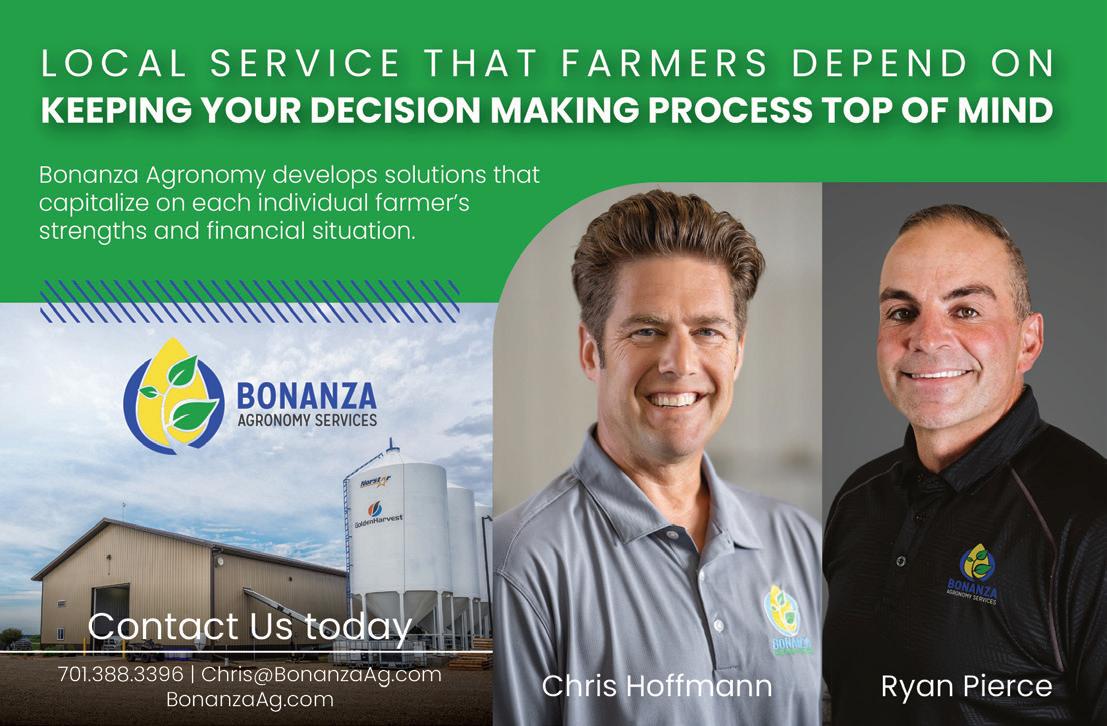

I’M ALL EARS (OF CORN)
by sam kise
WHEN YOU’RE OUT ON THE FARM ALL DAY, IT’S HARD TO FIND TIME TO KEEP UP WITH AGRICULTURE NEWS AND IMPORTANT ADVANCEMENTS IN THE FIELD. THESE PODCASTS—WHICH CAN BE LISTENED TO WHILE YOU WORK—MAKE IT MUCH EASIER TO GET THE INFO YOU NEED WITHOUT HAVING TO FIND TIME TO SEARCH FOR IT AND READ IT. WITH A VARIETY OF STYLES AND TOPICS, THIS LIST OF PODCASTS IS SURE TO HAVE SOMETHING FOR EVERYONE’S LISTENING PLEASURE.
*Note: This is not a comprehensive list.
A Better Way to Farm Podcast
A Better Way to Farm Podcast focuses on showing farmers how to “take control of inputs and maximize profit so [they] can farm the way [they] want.” The host, yield specialist Rod Livesay, focuses on helping farmers lower farm input costs that are raising due to global shortages. Recent episodes include “Keys to Running a Business First Family Farm with Jolene Brown” and “Passing the Torch: Navigating Farm Succession Planning with Elaine Froese.”
abetterwaytofarm.com/podcast
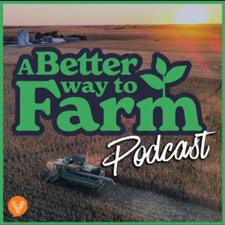
Hosted by Fargo’s own RDO Equipment Co., the Agriculture Technology Podcast provides the latest news and information on the advancements and innovations in the ag-tech world. Recent episode topics include the history of fertilizer and John Deere’s new ExactShot technology, farm data analysis, TruSet Active tillage equipment, and more!

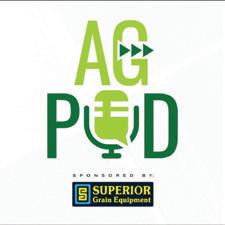
rdoequipment.com/resources/podcasts
Agweek’s podcast, produced by Fargo’s own Forum Communications, “brings you the latest agriculture news from around the upper Midwest.” The podcast provides reports on the market as well as other agriculture news. Recent episodes include “Farmland prices, Waubun meat processing, Agweek Livestock Tour;” “Grain markets focus in on South American weather, while the cattle market gets a friendly report” and “Building collapse, oat marketing group, Mikkel Pates' retrospective.”
agweek.com/podcasts/agweek-podcast
24 JAN/FEB 2023
Agweek Podcast Agriculture Technology Podcast
LISTEN TO THESE AGRICULTURE PODCASTS WHILE YOU WORK THE FIELDS

American Ag Network
Based out of Fargo, the American Ag Network podcast “provides agricultural news, market information, ag weather and other information to keep America’s farmers and ranchers informed.” Episodes are brief and concise, offering only the most important information for farmers and ranchers. They offers multiple episodes and clips weekly. Recent episodes include “Don’t Delay 2023 Fertilizer Decisions” and “New Law Offers Clarity on Carbon Market.”
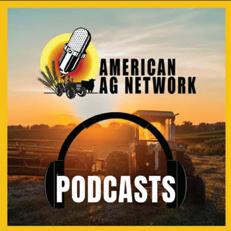
americanagnetwork.com/american-ag-today-podcast/
Barn Talk
Barn Talk is a podcast hosted by father and son, Sawyer and Tork Whisler. The podcast discusses topics like Ag business, investing, current events, entrepreneurship and more, with their goal being “to promote agriculture in a positive light, while relating with everyday Americans in discussing kitchen table topics.” Recent episodes include “How To Run A Successful Trades Business w/Mike Miller” and “Barn Talk Hot Topics: Consumerism, The AI Revolution & Pro Athletes Buying Farm Land.”
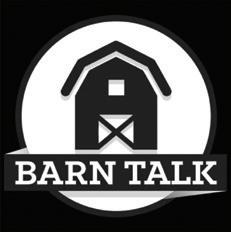
podcasts.apple.com/us/podcast/barn-talk
Bootstrap Farmer Radio
Bootstrap Farmer Radio is a podcast that “focuses on empowering growers and gardeners with the knowledge and resources they need to be successful, whether they are backyard gardeners, flower farmers or market farmers.” They interview expert farmers to give tips to other growers, whether they are new to agriculture or seasoned farmers. Podcast topics include “USA-made products like our greenhouses and seed trays, microgreens, aquaponics, flower farming, propagation, and more.”
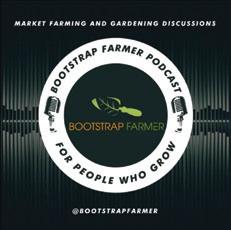
bootstrapfarmer.com
The Business of Agriculture Podcast
Host Damian Mason travels the world talking to audiences about trends in the business of food, fuel and fiber. Mason interviews industry professionals and provides commentary about relevant current agricultural topics. The Business of Agriculture Podcast “offers tips for success, ideas for self betterment, and mental stimulation for people who make Agriculture their Business.” Recent episodes include “Adding Margin And Diversifying Farm Income Via Direct To Consumer Ag” and “A New Revenue Stream for Farm Acres Via Ecosystem Services.”
damianmason.com/ag-business-podcast

FUTUREFARMERMAG.COM 25
The Direct Farm Podcast
The Direct Farm Podcast, produced by Barn2Door, features industry experts and farmers as they explore the “4 Levers for Farm Success: Quality, Brand, Price and Convenience.” The hosts discuss new insights, success stories, tactics and data-informed best practices for farms selling direct-tomarket. Recent episodes include “A Profitable Farm Business is a Sustainable Farm Business” and “Does your Farm have a Google Business Profile?”
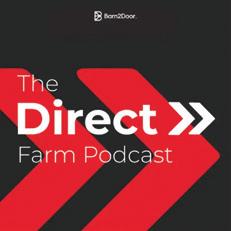
directfarmpodcast.com
Discover Ag
Discover Ag, hosted by Natalie Kovarik and Tara Vander Dussen, shares “relevant and captivating conversations in Agriculture so you can better understand the food system, and connect with the hands that feed us.” Recent episodes include “Advocacy: Packer Processing with MERCK,” “Joe Rogan, Lucky Charms & Steak” and “Climatarian is so 2022.”
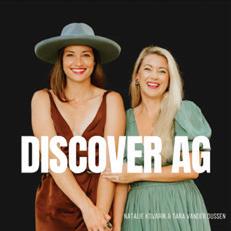
pod.link/1615443750


Farm Answers
Farm Answers is a newer podcast, started at the tail end of 2022. The podcast “takes a deeper look at projects funded by the United States Department of Agriculture, National Institute of Food and Agriculture’s Beginning Farmer and Rancher Development Program (USDA-NIFA BFRDP) and how they are reaching beginning farmers and ranchers.” The hosts interview project directors to better understand how the projects are helping U.S. Agriculture continue to thrive. Recent guests include Lucy Spence of Refugee and Immigrant Self-Empowerment (RISE), Robin Hackett of the Ohio Ecological Food and Farm Association, and Margaret Morgan-Hubbard of ECO City Farms.
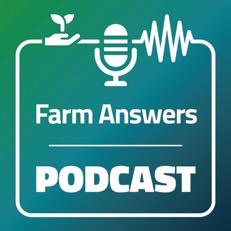
farmanswers.org
FarmBits Podcast
The FarmBits Podcast helps navigate the ever-changing technologies of agriculture by “discussing current and honest information about these technologies to best integrate them into resilient strategies.” The podcast explores topics in digital agriculture in an accessible way, helping farmers and ranchers to understand new technologies through interviews with academics, farmers, and industry specialists. Recent episodes include “Pest Predictions with Pattern Ag” and “Insightful Irrigation from Valley.”
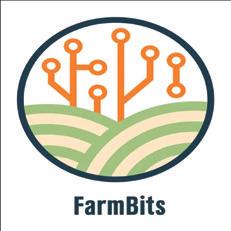
mediahub.unl.edu/channels/39344
Farm4Profit Podcast
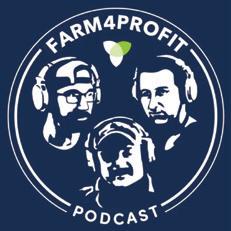
The Farm4Profit Podcast aims to “provide farms and operators an independent and unbiased outlet for information related to increasing the profitability of their farming operation.” The hosts Tanner Winterhof, David Whitaker and Corey Hillebo will “take each episode to deliver latest news, what's working for active farms, and a topic of focus each episode.” Recent episodes include “Could The H2A Program be a Solution for Your Farm?” and “Finding the Right Entity Structure for You.”
farm4profit.com
26 JAN/FEB 2023
Farm to Table Talk
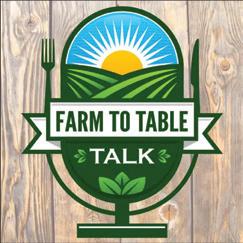
Farm to Table Talk is a podcast that is “a virtual table for conversations about ideas, insights, and journeys of chefs, farmers, policymakers, researchers, NGOs and the foodfocused public about our food and how it is grown, prepared and shared throughout society.” Rodger Wasson, the host, is a food and agriculture veteran. The podcast is for “those interested in journeys within the modern food system and the stories behind our every bite.” Recent episodes include “Eco Farm Eco Fish” and “Meetings of the Minds –Tara Vander Dussen, Natalie Kovarik.”
farmtotabletalk.com

Farmerama is a podcast that shares the voices behind regenerative farming. The hosts are “committed to positive ecological futures for the earth and its people, and [they] believe that farmers of the world will determine this.” The podcast “share[s] the experiences of grass roots farmers instigating radical change for the future of our food, our health, and the planet.” Recent episodes include “Community Gardens in Tamaki Makaurau and Organic No-Till Vineyards” and “Community Gardens, Plastic Pirates, a Farmshop Club and a Multi-Business Farm.”

farmerama.co
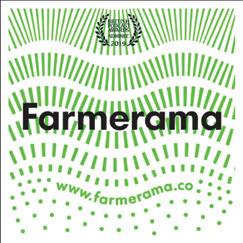
Farmerama Field Work
The Field Work podcast is hosted by Zach Johnson and Mitchell Hora, two commercial row-crop farmers, and Tara Vander Dussen, a dairy farmer. The podcast “provides space for frank, realistic discussions about the benefits and challenges of sustainable agriculture.” The hosts discuss “the successes and challenges farmers experience as they adopt new practices, while still getting into the weeds on the difficulties.” Recent episodes include “New Mexico Milkmaid Shines in Field Work Debut” and “The Hunger for Regenerative Ag Data.”
fieldworktalk.org

FOCUS on Agriculture
The FOCUS on Agriculture Podcast—hosted by Preston Schrader and Jason Carr, scientists in the ag industry—focuses on topics like digital ag, pests, sustainability and increasing yield while interviewing industry experts. Their goal is to “help growers succeed and open a dialogue with consumers.” Recent episodes include “Don Ort - Improving Crop Yields by Increasing Photosynthetic Efficiency” and “Stu Ellis - Half a Century of Changes in Agriculture.”
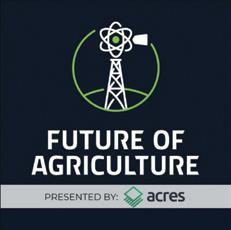
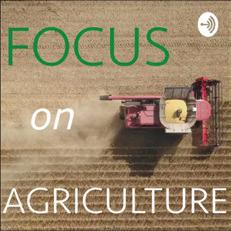
podcasts.apple.com/us/podcast/focus-on-agriculture
Future of Agriculture
The Future of Agriculture podcast “explores the people, companies, and ideas shaping the future of the agriculture industry.” Host Tim Hammerich “talks to the farmers, founders, innovators and investors to share stories of agtech, sustainability, resiliency and the future of food.” Hammerich himself is a formidable member of the agricultural community, having founded AgGrad.com and serving as the national Future Farmers of America president. Recent episodes include “Upcycled Fruit with Ben Moore of The Ugly Company,” “Comparing 13 Different Carbon Programs with Dr. Alejandro Plastina” and “Alphabet's Moonshot to Scale Sustainable Agriculture via Machine Learning with Dr. Elliott Grant of Mineral.”
FutureOfAg.com
The Modern Acre
The Modern Acre podcast, hosted by fifth-generation farmers, entrepreneurs and brothers, Tim and Tyler Nuss, brings in experts each week to talk about the changes in the food and agriculture industry on and off the farm. Recent episodes include "AgTech in 2023 Deep Dive with Verdant Robotics Founders Gabe Sibley and Curtis Garner,” “Farmer Trey Hill on Carbon Markets, AgTech, Regenerative & More!,” and “Connecting Brands and Farmers through Outcomes-Based Regenerative Agriculture with Chris Kerston, Co-CEO of Land to Market.”
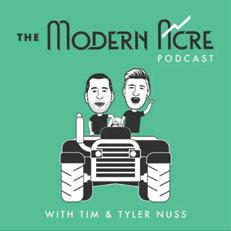
themodernacre.com

Precision Farming Dealer Podcast
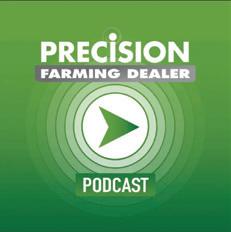
The Precision Farming Dealer Podcast is “the farm equipment dealer's audio sources for information on precision farming technologies and their application, as well as how to market, sell and service for increased customer value.” It is a business-focused podcast that helps farm equipment dealers understand how to better run their business. Recent episodes include “The Best Of ’22: Mainstream Autonomy, Benefits Of Dealer-Agtech Partnerships & Celebrating 30 Years” and “New Holland’s New Hay & Forage Precision Products Provide “Good Point Of Entry” For Customers.”
precisionfarmingdealer.com
SharkFarmer Podcast

On the SharkFarmer Podcast, Rob Sharkey (also known as the Shark Farmer) interviews farmers and hunters from around the country to get their perspective on the ag industry. Recent guests include Heidi Denbigh, a first-generation dairy farmer; Ryan Peter, an Illinois farmer who started an oil business; and Randy Nessman, the “Master Pipe Layer.”
sharkfarmer.com/podcast
28 JAN/FEB 2023
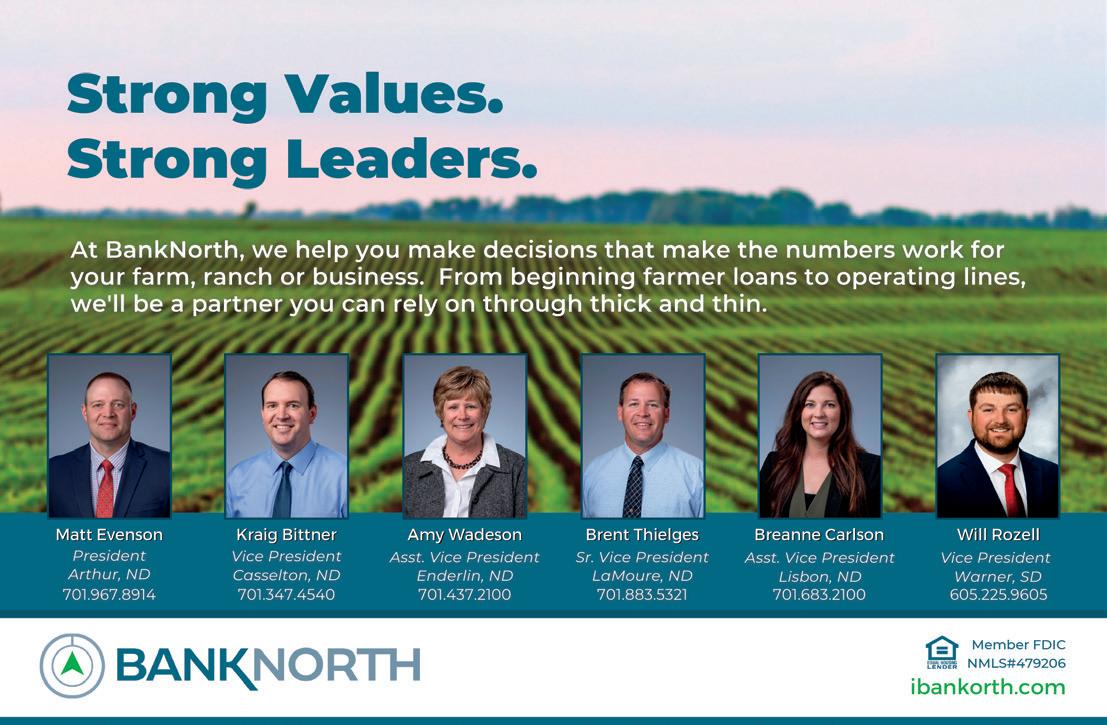
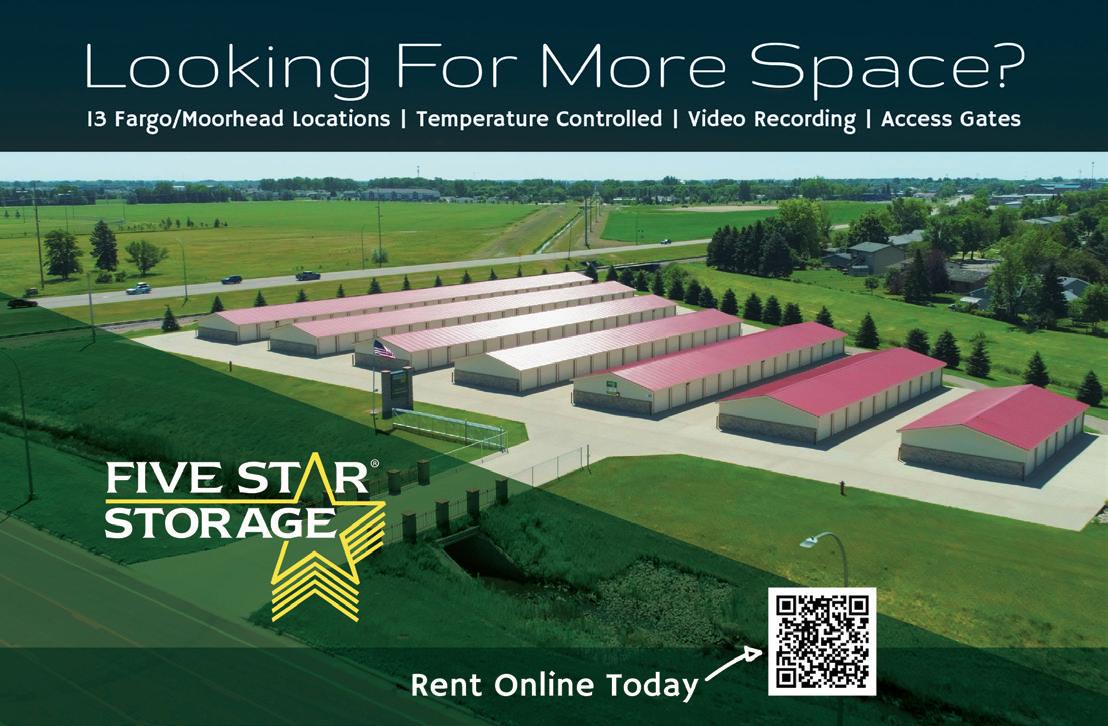
Small Farm Nation
The Small Farm Nation podcast, hosted by Tim Young, is a podcast about the business of smallscale family farming and homesteading. The podcast addresses topics like how to market and grow your farm business; how to find customers, sell at farmers markets, grow your CSA and build your farm email list; and how to grow your farm business from the ground up. Recent episodes include “How to respond to ‘why are your farm products so expensive?’” and “Should you partner with other farmers?”
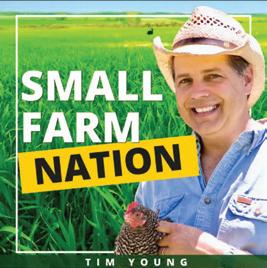
smallfarmnation.com/podcast-2
Straight Talk with NDFB
Straight Talk with NDFB—the North Dakota Farm Bureau—is a podcast that covers agricultural updates from the North Dakota Legislative Sessions. Host Emmery Mehlhoff covers all things agriculture for those who want to know more. Recent episodes include “How North Dakota's Youngest Legislator is Working to Grow the Dairy Industry” and “How Will Agriculture Issues Be Addressed in the 2023 ND Legislature?”

ndfb.org/straight-talk


Successful Farming Daily
From the Successful Farming news site, the Successful Farming Daily podcast goes through the top three biggest agriculture stories of the day each weekday morning. The podcast allows farmers and ranchers to get the news, weather and markets information that they need to start the day.

agriculture.com
Successful Farming Podcast
The Successful Farming Podcast, run by the Successful Farming news site, goes “in-depth into the topics that affect farmers and ranchers. Hear from industry leaders and experts on topics ranging from agronomy, technology, rural lifestyle, ag policy, farm machinery, and more.” Recent episodes include “Advice for a Beginning Farmer | Farmers for the Future” which features farmer Justin Zahradka from Lawton, ND and “An Alternative Weed Strategy | Weeds Playbook” which addresses how farmers need to attack weed problems head-on and not wait to deal with them.
agriculture.com/podcast
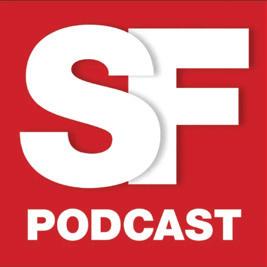
30 JAN/FEB 2023
This Week in Agriculture
The This Week in Agriculture podcast, hosted by the Red River Farm Network out of Grand Forks, provides a brief look at the top agriculture stories of the week every week.

rrfn.com/podcast_category/this-week-inagriculture/
Vertical Farming Podcast
Vertical farming “ensures reliable yield and consistency in crop production year-round with climate control, and no effects of external environment factors such as diseases, pests, or predator attacks.” Hosted by Harry Duran and based out of Minneapolis, MN, the Vertical Farming Podcast features “fascinating conversations with CEOs, Founders and luminaries from the exciting and fast-growing world of Vertical Farming.” Recent episodes include “Tim Hade/Scale Microgrid’s - Tackling Climate, Energy, & Hunger Through Vertical Farming” and “Dr. Isaac Berzin/Vaxa Life’s - The Complexity of Algae & A Quest for Sustainability.”
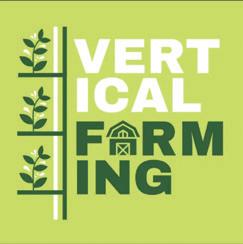
verticalfarmingpodcast.com
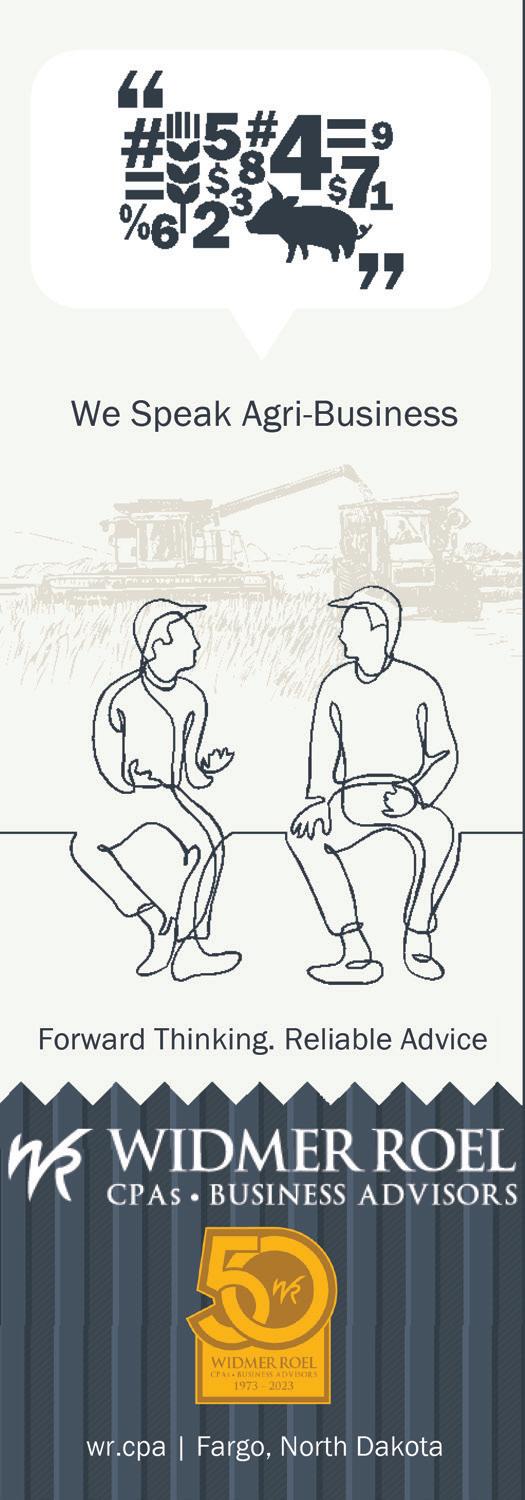


&
Grow Your Network Cultivate Your Education
 By Sam Kise
By Sam Kise
Networking is an important part of running any business, and it is no different when you are running an agriculture business. It’s also important to keep up-to-date on the most efficient and effective agricultural practices to ensure your business is running as smoothly as possible. Attending one of these agricultural events or conferences (or several of them) will help you meet experts in the field and expertly operate your business. Note: this is not a comprehensive list.
Local & Regional Events/Conferences
International Crop Expo
The International Crop Expo is a two-day event full of educational seminars about crops farmed in the Midwest like potatoes, soybeans and small grains. The event is developed and presented by North Dakota State University Extension and Minnesota Extension Services and takes place in Grand Forks, ND, at the Alerus Center. Keynote speakers for 2023’s conference include Rob Sharkey, an Ag expert and grain farmer who hosts two farming podcasts and a PBS farming show, and Brian Carroll, director of the Grand Farm.
cropexpo.com
When: Wednesday, February 22, 9 a.m. to 5 p.m. & Thursday, February 23, 9 a.m. to 4 p.m.
Where: Alerus Center, 1200 S 42nd St, Grand Forks, ND
Facing the Future Together: Energy and Ag
Part of the “Eggs & Issues” series, “Facing the Future Together: Energy and Ag” will cover “the recent history and trends of ag and energy, how the two industries advance together and depend on one another, and what lies ahead in the coming months and years.” The speakers will also be “unpacking each industry, how foreign conflict has or has not affected our region, economic drivers, new and innovative efforts, and what activities and initiatives will need to launch, continue, or evolve if we are to remain a healthy and powerful region.” Speakers include Dr. David Ripplinger, Associate Professor at NDSU; Mike Keller, President of Green Bison Soy Processing; and Monte Peterson, U.S. Soybean Industry Expert. The panel will be moderated by Dr. Greg Lardy, VP of Ag Affairs at NDSU. There are options for both in-person and virtual viewing.
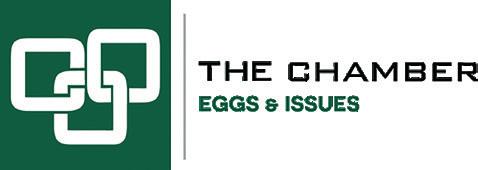
fmwfchamber.com

When: Thursday, February 23, 8 a.m. to 9:30 a.m.
Where: Courtyard by Marriott, 1080 28th Ave S, Moorhead
Registration Cost: $40 virtual $40 in advance $50 at the door
32 JAN/FEB 2023
Minnesota FFA Alumni and Supporters Annual Conference
The Minnesota FFA Alumni and Supporters Annual Conference is a dedicated event for Alumni and Supporters of the Minnesota branch of Future Farmers of America (FFA). The conference includes leadership and personal development workshops, networking opportunities and entertainment. The keynote speaker of the weekend is Tim Eggebraaten, a retired police officer whose presentation “Finding Your Beat, the Rhythm of Life” focuses on creating balance in stressful careers and situations. You can also catch Eggebraaten performing his one-man music and comedy show for the conference on Friday night!
mnffaalumni.org
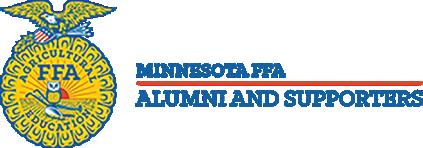
Space ag conference
The Space Ag Conference hosted by the University of North Dakota Space “seeks to explore the potential of advanced agriculture technologies to transform the AgTech industry in space, with the understanding that solutions to space-based challenges can often be applied to those on Earth.” At the 2023 conference, there will be a focus on getting the younger generations interested in agriculture—especially Space Ag. Look to the cover story for more info!
grandfarm.com/space-ag-conference
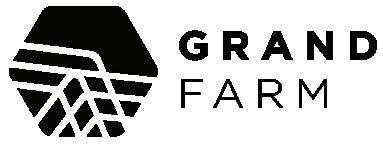
PEAK 2023 - Where North American Poultry Connects
PEAK, which stands for Profitability, Experience, Advancement and Knowledge, is the Midwest Poultry Foundation’s annual conference that emphasizes on-farm poultry production. Conference events include education tracks, Poultry Ted Talks, networking events, PEAK Unhatched and the Student Careers Program. The programs are designed to give the audience the tools they need to operate a successful farm/company, foster community and cultivate their communication skills.
midwestpoultry.com
When: Friday & Saturday, March 3 & 4
Where: Central Lakes College, 1830 Airport Rd, Staples, MN
Registration Cost: $15 Adult Track (Friday)
$10 Student Track – Led by Past State Officers (Saturday)
$25 Adult Track (Saturday)
$50 Adult After Conference Tour & Social (Saturday)
When: Tuesday, April 4, 12 p.m. to 5 p.m.
Where: University of North Dakota, Grand Forks, ND
Registration Cost: $50
When: Monday-Thursday, April 10-13
Where: Minneapolis Convention Center, 1301 2nd Ave S, Minneapolis, MN
Registration Cost: Farmer-Processor – $50 (onsite $75)
Government/University/Poultry Organization –$50 (onsite $75)

Supplier – $300 (onsite $350)
University Students and Press – Complimentary Spouse and/or youth under 18 (with a paid registrant) – Complimentary

FUTUREFARMERMAG.COM 33
Conference on Agricultural and Forest Meteorology
The Conference on Agricultural and Forest Meteorology is hosted by the American Meteorological Society and focuses on how meteorology/weather impacts agriculture. Potential topics for the conference include advances in top-down and bottom-up approaches for constraining biogeochemical fluxes at ecosystem and regional scales and emissions and deposition of reactive gases and aerosols in the terrestrial biosphere; development and application of new instruments and techniques for studying surfaceatmosphere biogeochemical fluxes; emissions and uptake of reactive compounds from terrestrial ecosystems; measurements and modeling of turbulence transport and diffusion in and above plant canopies; monitoring the interactions between vineyards and orchards and their environment; plants and ecosystems’ water use strategies under limited environmental conditions and disturbances; progress in remote sensing of surface-atmosphere exchange; radiative fluxes in forest and agricultural systems; and revisiting the energy balance closure issue using the Eddy Covariance Technique.

ametsoc.org

The Future of Food USA Conference
The theme of 2023’s Future of Food Conference is “Future Fit Food: How Food and Drinks Brands Can Tackle Scope 3 Emissions, Scale Regenerative Practices and Drive Supply Chain Resilience Through a Nature-Positive Approach.” Speakers at the conference include Chris Adamo, Vice President of Public Affairs & Regenerative Agriculture Policy at Danone North America; Jess Newman, Senior Director of Ag & Sustainability at McCain Foods; Gina Asoudegan, Vice President of Mission and Regenerative Agriculture at Applegate; Scott Herndon, President of Field to Market; Katie Anderson, Director of EDF+ Business and Resilient Food and Forests at Environmental Defense Fund; Nira Johri, Vice President of Global Inclusion & Sustainability at Rich’s; Wayne Honeycutt, President & CEO at Soil Health Institute; Samantha Werth, Executive Director at US Roundtable of Sustainable Beef; Kelli McCune, Director of Freshwater & Food Transformation at the World Wildlife Foundation; and more!
innovationforum.co.uk/conferences/the-future-of-food-us
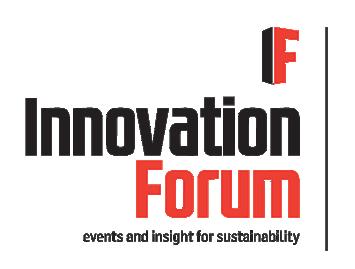
When: Wednesday & Thursday, May 31 & June 1
Where: Graduate Minneapolis, 615 Washington Ave SE, Minneapolis, MN
Registration Cost:
NGO/Academic Pass - $1,150
Standard Corporate Pass - $1,350
Service Provider Pass - $1,650
34 JAN/FEB 2023
Dakotafest
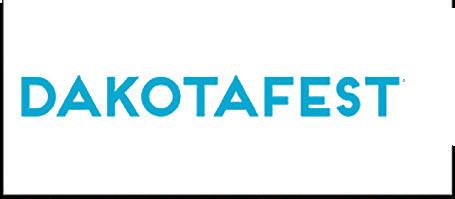
Dakotafest is an agricultural festival with a goal to help regional farmers grow their agribusinesses. The festival offers educational opportunities, the option to network with top agribusiness professionals and live demonstrations of various ag products to help producers excel at their craft. This event also offers agricultural item giveaways, family fun events and food vendors throughout the venue! ideaggroup.com/dakotafest
When: Tuesday-Thursday, August 15-17
Where: 2300 E Spruce St, Mitchell, SD
Registration Cost: At the gate - $10 Prior to the event - $7
Kids 17 and under - Free
Minnesota Crop Insurance Conference


The Minnesota Crop Insurance Conference is “one of the largest continuing education conferences for crop insurance agents in the Midwest.” Continuing education credits are available to crop insurance agents in Minnesota, Iowa, North Dakota, South Dakota and Wisconsin. Industry speakers will address topics directly relevant to crop insurance agents.
cffm.umn.edu/minnesota-crop-insurance-conference
When: Wednesday & Thursday, September 13 & 14
Where: Mankato City Center Hotel, 101 E Main St, Mankato, MN
Registration Cost: TBA

National Events/Conferences
Idaho Ag Summit

Though the focus of the Idaho Ag Summit is Idaho-based farming, there are topics relevant to all kinds of agriculture. The key speaker at the summit is Mark Limbaugh, the President of The Ferguson Group in Washington, D.C., who “provides strategic federal policy and legislative guidance to clients on water, irrigation, production agriculture, and other natural resource management and policy issues.” There will also be presentations from local ag experts and an award ceremony with Idaho Governor Brad Little. idahoagsummit.org
Southwest Ag Summit
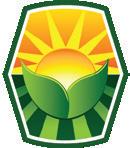
The Southwest Ag Summit is “the desert Southwest’s premier agriculture industry show.” The event provides “current content that growers will directly apply to their present cultural and management practices.” Presentation topics include irrigation management, immigration reform, fresh produce safety, crop protection, energy conservation and new cropping technology.
yumafreshveg.com/southwest-ag-summit
Iowa Specialty Producers Conference
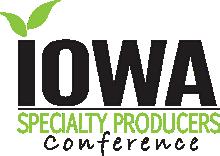
The Iowa Specialty Producers Conference is “an educational event for Midwest specialty crop producers to gather, network and grow in knowledge and experience.” The keynote speaker for both days of the conference is Jolene Brown: a farmer in Eastern Iowa, a contributor to Successful Farming magazine’s family business column, author of two books and an inductee into the Council of Peers Award for Excellence Speaker Hall of Fame. Her keynote addresses will focus on the business aspects of farming, including common mistakes that break up family businesses and factors that influence the attitudes of customers.
iowaspecialtyproducers.com

When: Monday & Tuesday, February 20 & 21
Where: Boise Centre West, 850 W Front St, Boise, ID
Registration Cost: $100 per person
$70 Young Farmer/Rancher (Under 40)
When: Tuesday-Thursday, February 21-23
Where: Arizona Western College, 2020 S Ave 8 E, Yuma, AZ
Registration Cost: $125 per person
When:Wednesday & Thursday, February 22 & 23
Where: FA Enrichment Center, 1055 SW Prairie Trail Pkwy, Ankeny, IA
Registration Cost: $220 for full conference; $150 for single day
36 JAN/FEB 2023
Nebraska Women in Agriculture Conference

The Nebraska Women in Agriculture Conference is “an annual two-day event designed to educate and uplift women involved in any aspect of Nebraska's agricultural industry.” The conference helps women in agriculture in five key risk management areas: production risk, market risk, financial risk, human risk and legal risk. The keynote speakers for the conference are Kiah Twisselman Burchett, a former California cattle rancher who is now a life coach, and Paul Stoddard, senior lecturer in the agricultural and consumer economics department at the University of Illinois Urbana-Champaign. wia.unl.edu/conference
Indoor Ag-Con
Indoor Ag-Con is the largest event for vertical farming and controlled-environment agriculture in the country. At this year’s convention, they are striving to expand and offer new opportunities for indoor farmers and supply chain stakeholders to connect and learn from each other. Presentation topics include the technology of growing crops in indoor systems and using hydroponic, aeroponic and aquaponic techniques. The keynote speakers of the conference include Arama Kukutai, CEO of the indoor vertical farming company Plenty, and Dave Chen, CEO of the sustainability-driven asset management firm Equilibrium. indoor.ag
Microbiome Movement/ AgBioTech Summit

The Microbiome Movement/AgBioTech Summit covers all avenues of agbiologic development. The summit brings together agbiologic developers, distributors and end-users/growers to learn from each other. Topics of discussion include navigating the agbiological regulatory landscape and understanding requirements for product approval; understanding the grower’s perspective with regards to adopting novel farming technologies; overcoming the formulation, manufacturing and scalability bottleneck without compromising product quality; leveraging the commercial landscape of the agricultural industry and paving your way to market; and exploring the fundamentals of the plant-soil microbiome and its implications for novel agbiologic development.
microbiome-agbiotech.com

When: Thursday & Friday, February 23 & 24
Where: Holiday Inn Convention Center, 110 2nd Ave, Kearney, NE
Registration Cost: $175 per person
When: Monday & Tuesday, February 27 & 28
Where: Caesar’s Forum Convention Center, 3911 Koval Ln, Las Vegas, NV

Registration Cost: $1095 full access
$100 expo floor only for farmers/growers
$1595 full access
$600 expo floor only for all others
When: Tuesday-Thursday, February 28-March 2
Where: Sheraton Raleigh, 421 S Salisbury St, Raleigh, NC
Registration Cost: $3,496 for conference + 3 workshops (industry pricing)
$2,671 for conference + 3 workshops (academic pricing)
$4,596 for conference + 3 workshops (solution provider pricing)
FUTUREFARMERMAG.COM 37
Ag Food & Policy Summit
The Ag Food & Policy Summit will focus on the 2023 farm bill, what types of federal farm programs are important and how funding should be distributed to support farmers, ranchers and the consumers who rely on them. At the summit, speakers and attendees will look at some of the ideas under development that will drive policy discussions for those involved in agriculture. The summit will also cover the topic of the availability and sustainability of crucial resources like land, water, and crop protection chemicals.
agri-pulse.com/2023-DC-Summit
Water for Food Global Conference

The Water for Food Global Conference will focus on “innovative ways to improve water and food security by increasing farmers’ resiliency to a changing landscape.” The conference will “provide a platform to explore win-win scenarios to support improved water use in agriculture and increase productivity at a variety of scales—from smallholders, collectives and coops to commercial farm operations—while preserving water resources for other human and environmental needs.” Presentation topics include climate change, technology to improve productivity and protect agroecosystems, water policy and management, capacity development, and people, animals and health.
waterforfood.nebraska.edu
Four-State Dairy Nutrition and Management Conference
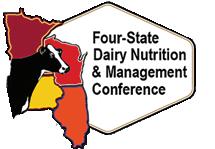
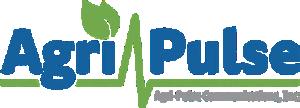
The Four-State Dairy Nutrition and Management Conference “presents the latest research on issues concerning the dairy industry including feed efficiency, calves and transition cows.” It is hosted by the University of Illinois, the University of Minnesota, Iowa State University, and the University of Wisconsin-Madison extension programs. fourstatedairy.org
When: Monday, March 20
Where: The National Press Club, 529 14th St NW, Washington D.C.
Registration Cost:
In Person Subscriber - $197
Virtual Subscriber - $97

In Person Non-Subscriber - $497
Virtual Non-Subscriber $397
When: Monday-Wednesday, May 8-10
Where: Nebraska Innovation Campus Conference Center, 2021 Transformation Dr, Lincoln, NE
Registration Cost: $500 regular in-person rate $50 virtual rate
When: Wednesday & Thursday, June 7 & 8
Where: Grand River Center, 500 Bell St, Dubuque, IA
Registration Cost: $150 per person
38 JAN/FEB 2023


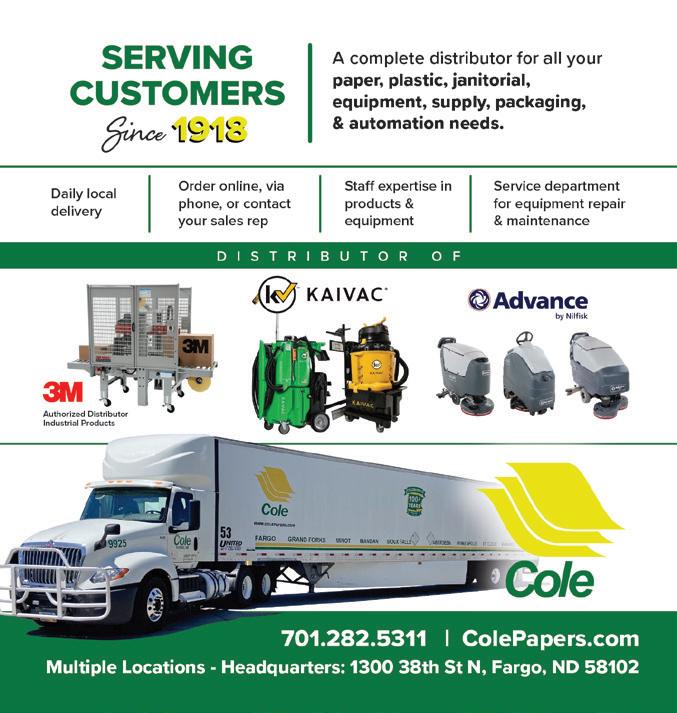
Looking to Make Running Your Farm Easier?
TRY THESE APPS!
Back in the day, farmers had to do everything the hard way. They had to put out rain gauges to check the rainfall in the fields, calculate potential crop yields by hand and scrounge around at the newspaper stand and listen to the radio to hear the current Ag news. Today, a farmer can have all of that and more in the palm of their hand! There are so many apps that have the ability to make farming and running an agribusiness easier, more efficient and up-to-date with the modern world. Try out these agricultural and farming apps to stay in the know about current agribusiness practices and make farm management less stressful.
AgriSync


Google Play & Apple App Store
AgriSync helps farmers and agribusiness advisors to connect and find solutions to agriculture and business problems. Farmers can connect with advisors in real-time via video to get help quickly. This service is free to farmers/producers!
AgWeb News & Market
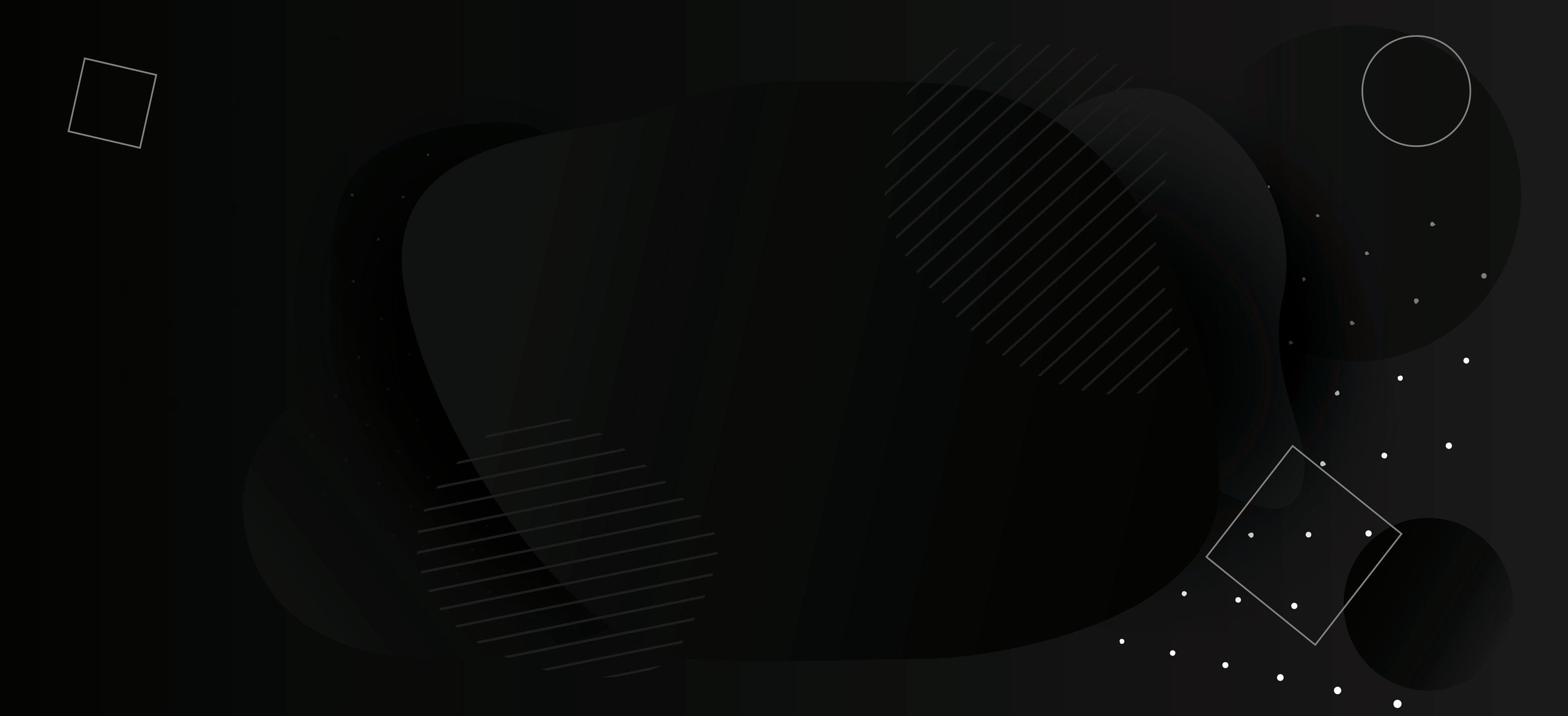
Google Play & Apple App Store
AgWeb offers a culmination of all kinds of agricultural news, from ag management to farm business to blog posts from farmers around the country. Get information about current markets and what other producers are doing through AgWeb’s news resources.

Farmbrite
Google Play & Apple App Store
Farmbrite is a farm and livestock record-keeping and management system that helps you run a more efficient agricultural business. Farmers can improve their business with the integrated farm and livestock record-keeping, planning, management, tracking, sales, and reporting software that Farmbrite offers. The mobile app includes an offline mode to allow scouting, task management and record keeping offline.
Farm Futures
Google Play & Apple App Store

The Farm Futures app is the mobile-optimized version of the Farm Futures magazine. Offering access to the leading managementoriented farm magazine, the Farm Futures app provides information on enhanced user-customized markets, market commentary, news and audio updated every business day.


40
JAN/FEB 2023
eKonomics by Nutrien
Google Play & Apple App Store
eKonomics by Nutrien is an all-encompassing farming resource. The app allows you to access accurate information and research tools from anywhere to give you better insight over your nutrient management. Important features include: an ROI Calculator that assists with making accurate nutrient application plans; a Growing Degree Days Calculator that is built to help you determine plant and pest development rates based on your farm’s location; a Nutrient Removal Calculator that can help you determine the amount of nutrients that need to be replaced in your soil after harvest and economic impact of nutrient replacement/ removal; and a Rainfall Tracker, which is helpful to track rainfall data and identify weather patterns and trends in your fields.


FARMap
Google Play & Apple App Store
FARMap allows farmers to map their farm and record all paddock and livestock treatments on their phone, tablet or computer. All data is stored in the account and is accessible from all devices, making sure you have all the info you need to create quality assurance reports anywhere you are. Farmers can also collaborate with multiple users to keep track of their farm or multiple farms within the app. Livestock recording options include mob movement, feeding, mating (which automatically creates dates for lambing/ calving) and chemical treatments. Paddock treatment recording options include chemical name and batch numbers, wind speed and direction and applicators details.

FarmLogs
Google Play & Apple App Store
FarmLogs is a farm management software application powered by Bushel. The app helps crop farmers manage digital farm records, monitor field and crop conditions, calculate cost of production to market grain and analyze their farms’ financial performance. Features include: the ability to map fields and automatically provide directions to their location; alerts when it rains on your fields; the ability to track all your field work in one place to keep your records organized, secure and accessible from anywhere; the ability to log GPS-tagged scouting notes with photos; ability to view in-season satellite images in NDVI, true color and color infrared layers to identify yield threats; a complete view of your current grain marketing position; technology to help identify local markets and find where you can get the best price for your crop; and the ability to see each soil type area and elevation features in your fields. FarmLogs assists with making farm management easier and more intuitive.
Granular Insights




Google Play & Apple App Store
Granular Insights is a farmer-focused app that helps you scout your fields more effectively. Imagery from satellites provides frequent imaging at high resolution for field-by-field insights. The satellite imagery is enhanced by Vegetation Index data science models and smart cloud cover detection. The app allows you to track your field conditions from anywhere at any time and invite others to collaborate with you, too.
Farm at Hand
Google Play & Apple App Store
Farm At Hand is a farm management app that helps farmers to organize tasks, allocate resources and record activities on their farm more efficiently to assist in making critical business decisions. Features include: Geographic Information System (GIS) capabilities, such as displaying map layers, pinning rocks and scouting; live market pricing for budgets and crop marketing plans; specific member notifications for activities, including scouting and spraying; and the ability to manage pricing, contracts and storage log of crop inputs. The app also allows farmers to collaborate with their team in-app and get custom recommendations based on their entered crop data.
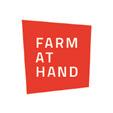
FUTUREFARMERMAG.COM 41
Nutrien Pocket Rain GaugeTM
Google Play & Apple App Store
If you’re only looking to gauge the rain that your crops receive, Nutrien’s Pocket Rain Gauge is a free tool that gives you access to reports of total rainfall in your area or your field for the previous 24 hours. To ensure accuracy, Nutrien uses meteorological information drawn from reliable data sources.
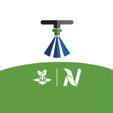

Nutrien Pocket Spray SmartTM
Google Play & Apple App Store
Looking for a good time to spray your fields? Nutrien’s Pocket Spray Smart uses GPS technology to help make sure you are spraying in the perfect conditions. The app shows you meteorological conditions like current and forecasted wind speed, direction and atmospheric inversion potential that may affect the application of spray-based products.


TractorHouse

Google Play & Apple App Store
Sirrus
Google Play & Apple App Store

Sirrus assists agronomists and farmers in collaborating on farming decisions by making field data easily accessible and collectible. Key features of this app include: the ability to scout crops for pest pressures and easily record and collect observation photos; the ability to create and share recommendations from the field; the ability to generate PDF reports and share them with collaborators; the ability to record soil samples using a grid, zones or previous soil sampling points; fertilizer and nutrient recommendations; the ability to receive rainfall estimates updated to the hour for each field; and more. Sirrus also offers a premium subscription for a fee. The premium version includes extra features, including an Advanced Fertilizer Recommendation Editor that allows you to edit variable rate recommendations by total product or cost; Product Labels/Safety Data Sheets (SDS) that allow you to view up-todate product information, labels, SDS and store for offline use; Variety Tech Sheets that allow you to view and share variety traits/ information and store for offline use; Premium Reports that cover your scouting and recommendation communication needs; and a Recents Search, a tool to increase efficiency in recommendation creation by sourcing previous activities.

42 JAN/FEB 2023
Buying brand-new farming equipment can be incredibly expensive,
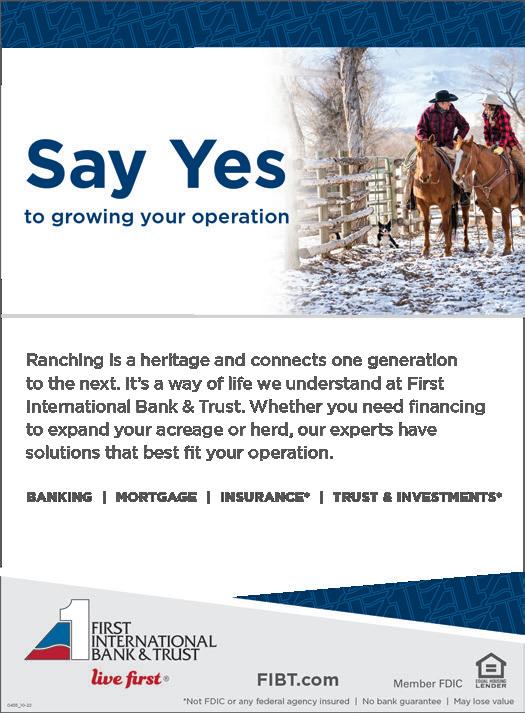
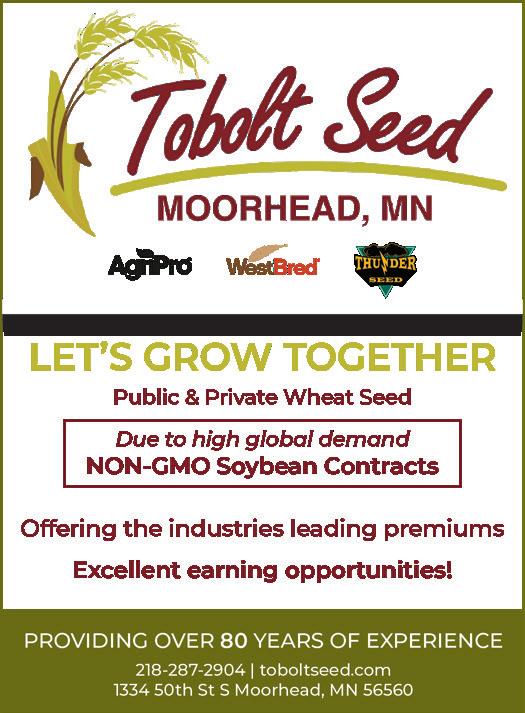

Bill Mongeon
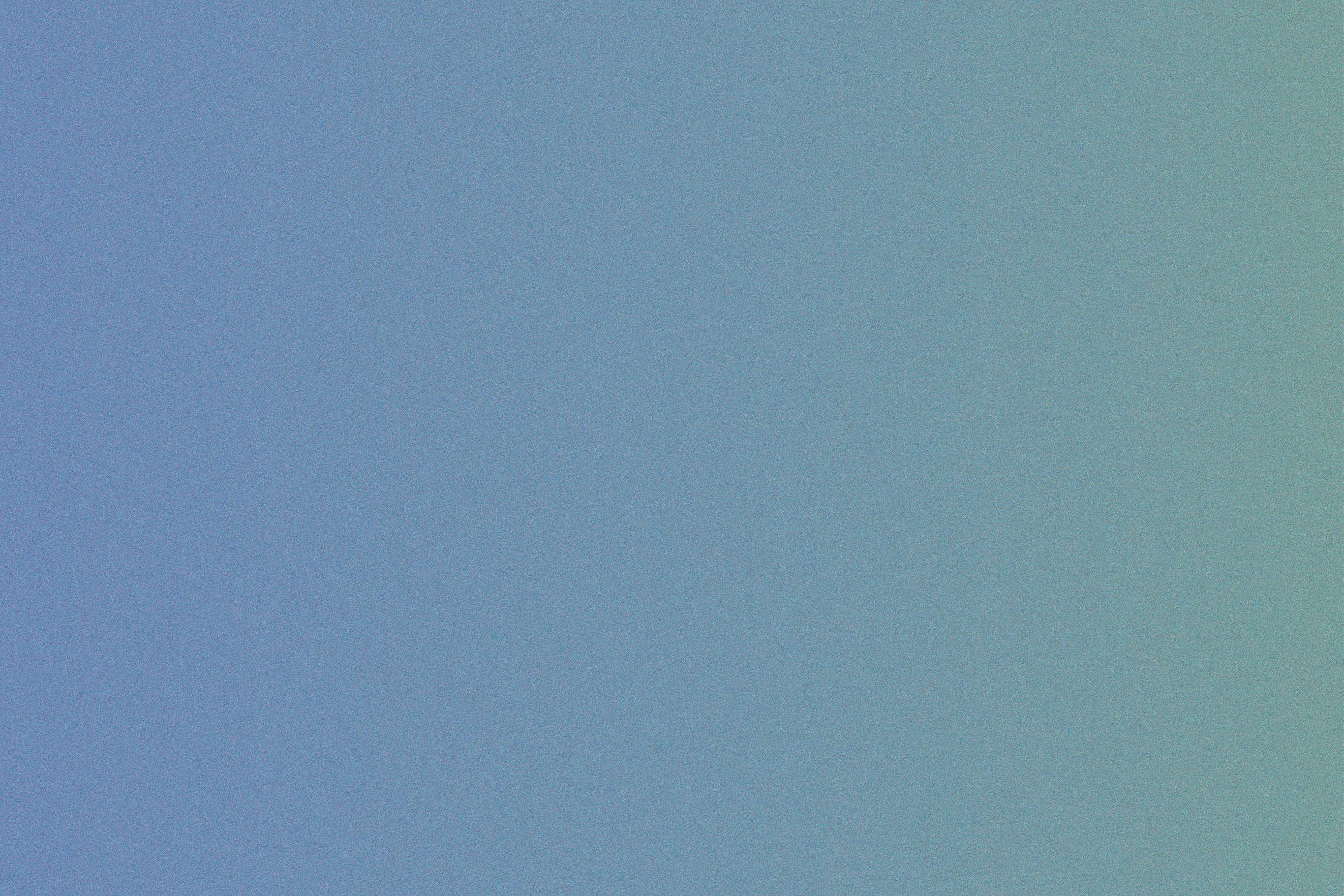
Rolette, ND
Growing up on the family farm in Rolette, North Dakota, as a child, Bill Mongeon remembers that there was always something to do. "It was always a steady job from when you grew up," he said. "You were never without work." Though this sort of lifestyle may sound strange to people who didn't grow up in a farming environment, for Bill, farming has always been his life. We sat down with him to learn more about his story and life on the farm.
Being raised on the family farm provides plenty of opportunities for not just working together and staying busy, but instilling a family culture in the operation as well. Bill and his brother are third-generation farmers, with his son Garrett and nephew Matt entering the operation as fourth-generation farmers. In many ways, the Mongeon farm is in a transitional state right now, with Matt currently being full-time in the family farming operation while Garrett is just finishing up college, deciding which path will be right for him.

For many, choosing a vocation means leaving your childhood home for good, setting out to create something fresh. But for Bill and many before him, his vocation was found right at home, investing in the
farming legacy of his ancestors and sharing that with his own children. Bill himself even set out to pursue something outside farming. He left North Dakota and studied Diesel Tech for a year in Wyoming. Yet when he was called upon, he returned to the family farm to help with the harvest. That was 1985, nearly 40 years ago, and Bill is still a farmer to this day.
Having been a farmer for nearly 40 years, it's safe to assume Bill has found something he truly loves. "I love the wide open country," he said. "I love being outside—there's just [a feeling of] peace and calm in the early mornings."
Bill is his own boss, which he says is both a good thing and a bad thing, because you're in charge of everything you do, yet in the end, it's always rewarding because when push comes to shove, it's up to you to make things happen and the lasting result is very fulfilling. "It's just one of those jobs where you have to be on your toes all the time and learning all the new stuff there is to learn all the time because [farming] is constantly evolving."
44
Photo provided by Bill Mongeon
JAN/FEB 2023
It's just one of those jobs where you have to be on your toes all the time and learning all the new stuff there is to learn all the time because [farming] is constantly evolving."
In terms of evolving, Bill has seen farming and ag tech do so immensely over the last 30-some years. Although technology played a role in farming when he was just getting started, it's nothing compared to the technology that goes into a farming operation today. "When we started out, it was a lot more relaxed," he said. "We learned at a young age how to run equipment; you just jumped on a tractor, and all you had to do was go work the ground and keep the weeds from growing. If you made a mistake, it wasn't a big deal. Nowadays, every pass you make in a field has a pretty specific purpose. And you don't just jump out there and go, you have a lot of technology involved in what's going on."
Farming has become less like just driving a tractor and more like running an air traffic control tower; there are so many moving pieces and data points to make everything run smoothly. Today, mistakes are less forgiving. Whether it be machinery or chemicals, farming operations are just more expensive to maintain and more costly for mistakes.
"The fertilizers are expensive, so we're trying to maximize profits where the land is good, and then minimize losses where it's bad," Bill said. "We're constantly trying to find all of our operating costs to maximize return."

When it comes to implementing technology, Bill's mid-sized farming operation runs smoothly with the help of many software and tech tools. One of his favorites is a software for planning and tracking yields called Climate Fieldview. This tool allows him to track and compare varieties, fertilizers and store info from each year all in one database, which in turn enables him to see where costs are going and where he can create better efficiencies in his operation.
"I always used to embrace [technology] when I was younger, and now as I'm getting older, it's time for the younger generation to take that
over—it's kind of overwhelming sometimes," Bill laughed. Thankfully, his son Garrett and nephew Matt are at the helm ready to take over the operation someday.
If Bill could offer any advice to other farmers, he believes that technology is going to continue to be a valuable tool in farming and that it's important to keep an open mind about the technology of tomorrow. "From [the time] I started, things have changed so much," he said. "I've heard stories from when my dad was young and how much it's changed, and for me to look at what the technology is going be like even 10 years from now is kind of mind-boggling, because it's an everchanging business and it's getting to be more and more high tech all the time."
Yes, adding more acres to your operation is one way to grow, but Bill credits technology as a large factor in what's given him the opportunity to grow and do a better job. The very essence of Future Farmer Magazine is to tell the stories of those embracing technology and positioning themselves to be successful, not just today, but tomorrow for the next generation as well. There are a lot of tools available to help farmers grow and maximize their yields, the technology that's been behind a lot of these seeds, whether it's wheat, corn, soybeans or canola, has improved dramatically. There are a lot of technology and management practices that can be focused on to keep getting better.
And most importantly, Bill wants to thank his wife Gail.
"I couldn't do it without her. Farm wives don't really tend to get the notoriety they deserve, but they do deserve it. They put up with a lot of stress and she is amazing."
FUTUREFARMERMAG.COM 45

46 JAN/FEB 2023
Sandro Steinbach, Associate Professor, Director CAPTS, Challey Scholar, NDSU
by Jayson Lusk
"The Food Police: A Well-Fed Manifesto About the Politics of Your Plate" is a captivating read that delves into the complex world of food politics. Written by Jayson Lusk, this book examines the external forces that shape our food choices, including government regulations, media campaigns and special interest groups. But Lusk doesn't stop there—he also explores the economic, social and cultural factors that play a role in our food decisions. One of the things that sets this book apart is Lusk's thorough research and use of data to support his arguments. He draws on various sources, including academic studies and government reports, to build a strong case for a more nuanced and evidence-based approach to food policy. But despite its heavy subject matter, The book is highly readable and engaging. Lusk's writing is clear and accessible, making it a valuable resource for anyone looking to make more informed and mindful food choices. If you're interested in the politics of food and how it impacts our daily lives, this book is a must-read.

Xinhua Jia, Professor, NDSU
by Dr. Dickson Despommier

The vertical farm is about designing a city or a structure to be self-sustaining. Vertical farming is a concept of growing food vertically inside a structure, with energy efficiency, artificial lights and optimal nutrient in mind.
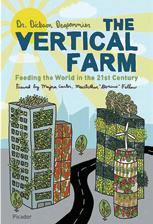 by Pam Dawling
by Pam Dawling
The "Year-Round Hoophouse" is about high tunnel design and applications. The Hoophouse book talks about the engineering design of a hoophouse (high tunnel), how to grow crops in the hoophouse and management practices in the hoophouse.
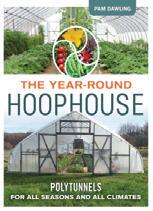
Both books are much needed in North Dakota and can help our citizens to have fresh produces year around.
Matt Olhoft, Sr. Lecture, Ag. and Biosystems Engineering, NDSU
by Carroll E. Goering and Alan C. Hansen
This book is important because it help with understanding your power units on a farm operation which is important to save money. Understanding how the machines work and having a good maintenance program will make a farm efficient and profitable.

"THE FOOD POLICE: A WELL-FED MANIFESTO ABOUT THE POLITICS OF YOUR PLATE"
"THE VERTICAL FARM: FEEDING THE WORLD IN THE 21ST CENTURY"
"ENGINE AND TRACTOR POWER"
"THE YEAR-ROUND HOOPHOUSE"
FUTUREFARMERMAG.COM 47
As 2023 comes into focus, there is a lot of exciting things going on at the Grand Farm. In each issue of Future Farmer, Emerging offers up insight into what's new and notable at the cross-section of start-ups and agriculture. This month, we learn more about Grand Farm's new innovation facility, Thread's large Series A funding push and more.

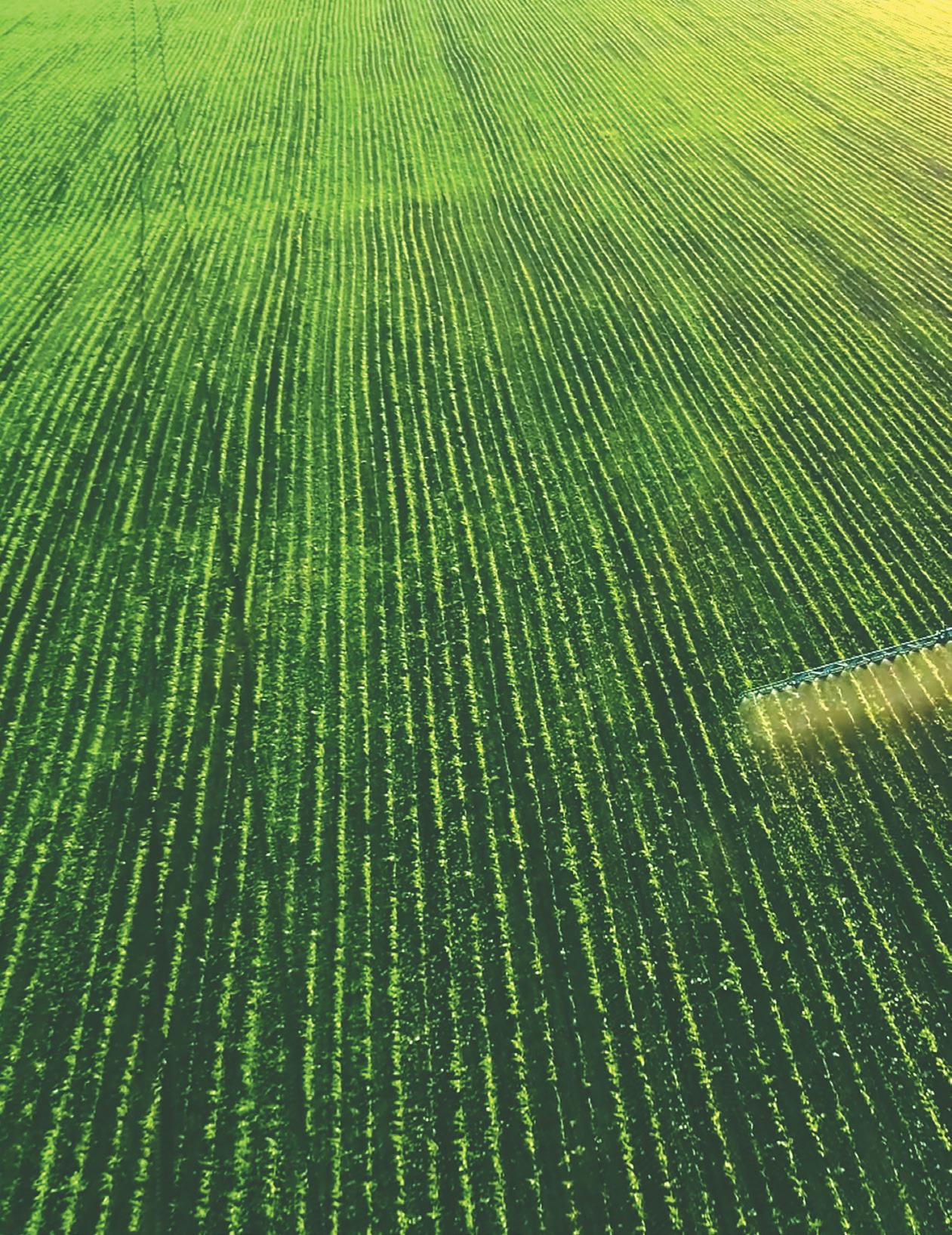
48 JAN/FEB 2023
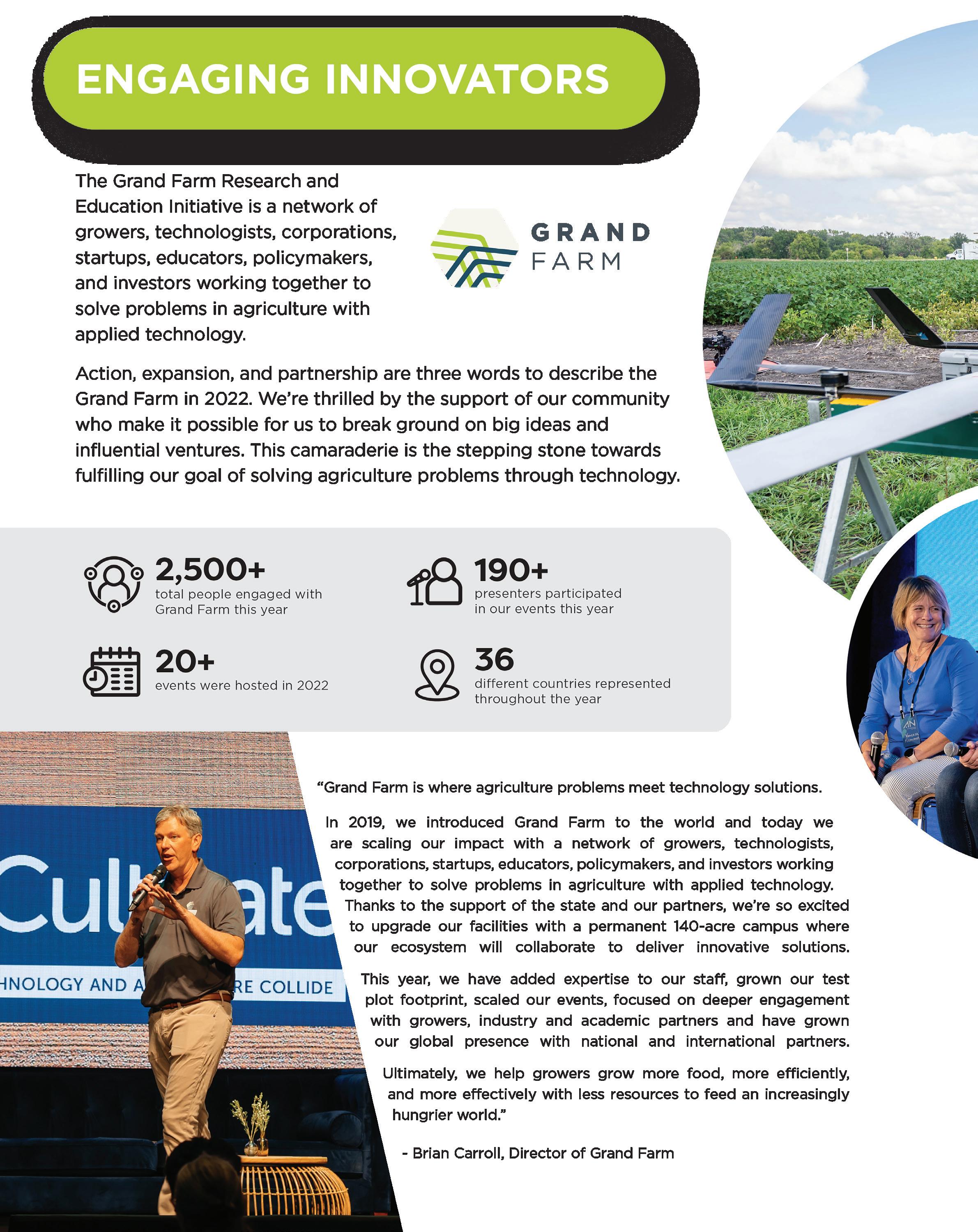
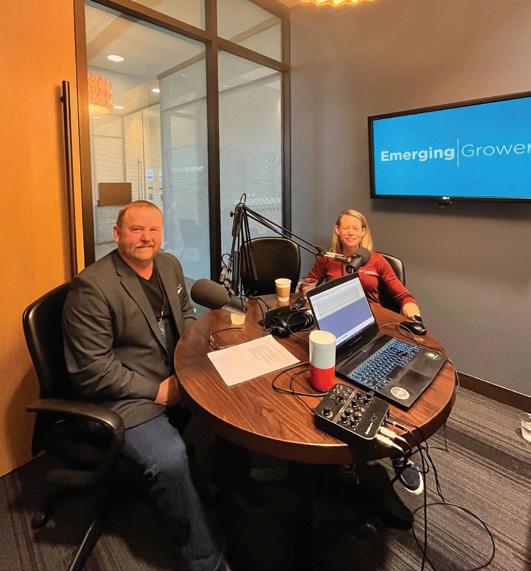
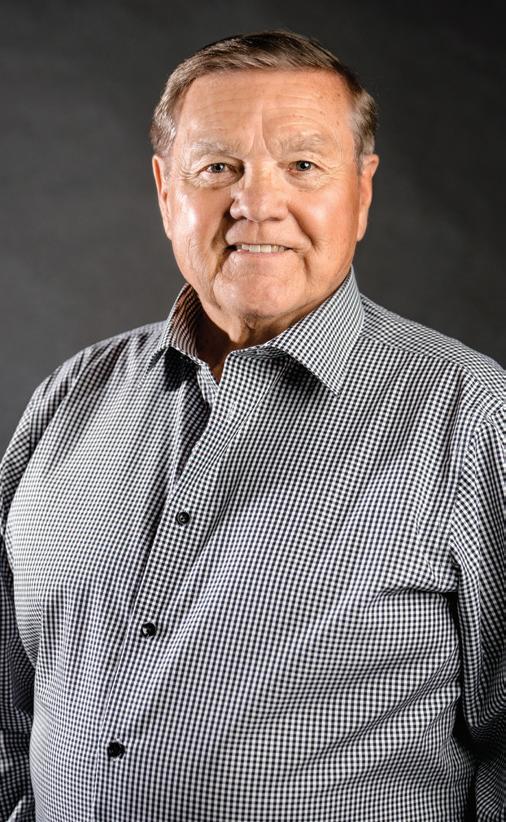
50 56 52 FUTUREFARMERMAG.COM 49
54 Discover the Emerging Grower Podcast Interviews!

50 JAN/FEB 2023
Grand Farm Announces 2023 Program and Event Schedule
Grand Farm is already underway preparing for the 2023 season creating events, conferences and workshops to accelerate solving agriculture problems with technology solutions. From space to the latest innovations to autonomous systems, take a closer look at what is on the calendar already! More information and registration can be found at grandfarm.com.
Space Ag Conference

April 4, 2023 Memorial Union, University of North Dakota grandfarm.com/space-ag-conference
Space Ag Conference seeks to explore the potential of advanced agriculture technologies to transform the AgTech industry in space, with the understanding that solutions to space-based challenges can often be applied to those on Earth. Our world’s production system is undergoing a dramatic shift towards sustainable practices and greater food security. Space agriculture and the technology it provides could help farmers produce higher crop yields with less land and energy. This is our opportunity to dream big and envision a bold future for agriculture.
Cultivate Conference




June 8, 2023 Fargo, North Dakota grandfarm.com/cultivate
Cultivate Conference is an agriculture technology conference that convenes innovators to explore technology innovations they’ve created, are currently building or are searching for in their industry. The conference seeks to energize the AgTech community by showcasing the latest innovation in AgTech and how it solves real world problems faced by the agriculture industry.
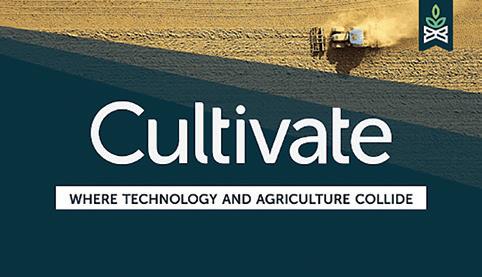
Autonomous Nation Conference
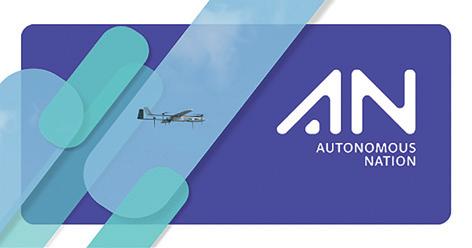
August 29, 2023 Fargo, North Dakota grandfarm.com/autonomous-nation
Autonomous Nation is a full-day conference bringing together policymakers from the local, state and national levels with industry entrepreneurs and innovators to help make our region the most autonomous-friendly area in the country. The conference will focus on the autonomous industry and the impact it can have across our region, solving issues such as workforce shortages, inefficiencies and technology gaps.
FUTUREFARMERMAG.COM 51
Emerging Prairie and Grand Farm recently announced its annual 1 Million Thanks Awards recognizing individuals and organizations that have made a significant impact in the startup, innovation, and technology communities. This year’s award recipients include:
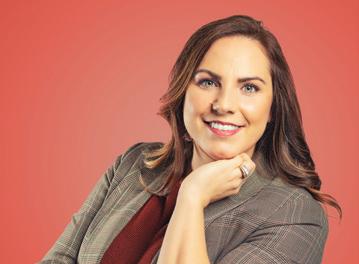

Gary Tharaldson
Dr. David Wells Belief Award
This award is given to individuals who believe in the potential of entrepreneurs and the difference they can make in our community. Gary Tharaldson is an entrepreneur and founder of Tharaldson Ethanol, Tharaldson Hospitality, and Tharaldson Investments. Gary has been a huge driver in making North Dakota the best place to thrive—whether it’s within the startup, technology, or innovation ecosystems.
North Dakota Small Business Development Centers Entrepreneur Community Champion

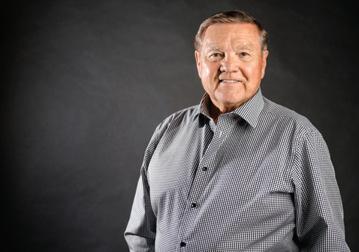
This award is given to organizations that contribute to the ecosystem in a meaningful way, allowing us to energize and elevate our startup community. The North Dakota Small Business Development Centers (ND SBDC) has a network of credentialed business advisors that work to empower North Dakota small businesses and entrepreneurs to thrive.
Jessie Azure
Kick-Ass Award
This award is given to early-stage entrepreneurs that have made significant progress throughout the past year. Jessie Azure is the creator and founder of Spadesso. In 2020, she saw a growing need to help consumers connect with local salon and spa providers, and made it her mission to bring faster and easier search & booking to salon and spa appointments. In April, she successfully launched Spadesso’s MIVP, the Appointment Finder.
About 1 Million Thanks
1 Million Thanks is an evening program dedicated to celebrating the incredible things that entrepreneurs, innovators, and technologists do in our community. It's a time to connect with old (and new!) friends, reflect on the amazing progress our community has seen over the past year, and look forward to the impact we'll make in the year ahead. Each year we have delicious appetizers, our signature champagne toast and live music.
The Grand Farm & Emerging Prairie
52
JAN/FEB 2023
KWS Group Grand Farm Champion
This award is given to an organization that drives immense agricultural innovation in our region. KWS Group is one of the world’s leading seed suppliers offering innovative solutions to farmers in 70 countries. Focusing on grower’s challenges and responding with innovative tools, technology and hybrid performance, KWS provides seed with high-performing genetics supporting today’s progressive farmers and producers.

Ron Holiday Innovative Grower
This award is given to an individual that provides helpful feedback and embraces the advancement of innovations in agriculture technologies. Ron is a 4th generation farmer who is originally from Naples, South Dakota. He grew up on a grain and livestock operation. He started working for Harvest Partners in the fall of 2006 near Casselton, North Dakota. In 2008, Ron took over operations for Harvest Partners where they raise corn, soybeans, wheat and edible beans.
Perficient Technology Workforce Champion

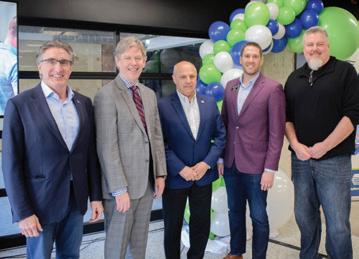
This award is given to an organization that has contributed in meaningful ways to support the technology community in our region. Perficient is a leading global digital consultancy with locations in the United States, Latin America and India. They imagine, create, engineer and run digital transformation solutions that help their clients exceed customers’ expectations, outpace competition and grow their business.
Jase Kraft Technology Community Advocate
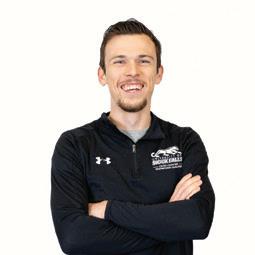
This award is given to an individual that has shown immense commitment to upskilling the technology workforce of North Dakota. Jase Kraft is a software developer and advocate for the advancement of technology in North Dakota. He currently hosts Full Stack Fargo, a monthly meetup dedicated to creating a community of full stack developers in the FM area.
 Ron Holiday stands on the far right among an important cast of characters.
Ron Holiday stands on the far right among an important cast of characters.
FUTUREFARMERMAG.COM 53
Emerging Prairie invites the community to celebrate the award winners along with the entrepreneurs, technologists, and innovators in our region at 1 Million Thanks from 7 - 10 pm on Thursday, January 26th at the Fargo Air Museum!
Discover the Emerging Grower Podcast Interviews!

This interview features Sarah Lovas, a grower and agronomist from Hillsboro, ND, and Mark Watne, a fourth generation farmer and president of North Dakota Farmers Union, to discuss the State of AgTech.
Emerging Grower is an agricultural podcast produced by Grand Farm that brings together growers and AgTech professionals to help accelerate conversations between emerging technologies in the agriculture industry. Emerging Grower is released wherever podcasts are found including on Spotify and Apple Podcasts. And now, Grand Farm is making the episode interviews available to Future Farmer readers.
Cameron MacNabb: Hello, and welcome to the very first episode of the Emerging Grower Podcast. Every episode will focus on bringing together growers and AgTech professionals to help accelerate conversations between the two fields and the agriculture industry. This podcast is energized by Grand Farm, which is enabling technology to feed the world by facilitating collaboration on innovations, solving some of the world's largest challenges in agriculture technology. My name is Cameron MacNabb and I'm a member of the Grand Farm team who is helping facilitate this podcast. In this month's episode, we have Sarah Lovas and Mark Watne discussing the overall state of AgTech. Sarah works for GK Technology as an agronomist, salesman and precision agriculture consultant. Mark is a fourth generation farmer. He grows a variety of crops including wheat, corn, barley, soybeans and many more. He currently works for the North Dakota Farmers Union and is the Union's ninth President. We hope you enjoy this interview that we recorded during our Autonomous Nation conference in August at Microsoft's campus in Fargo, North Dakota. We hope you not only enjoy the conversation between Sarah and Mark, but also gain valuable insight in the world of agriculture.

Sarah Lovas: Well, hello my name is Sarah Lovas. I'm a farmer and an
agronomist and a precision agriculture person from Hillsborough, North Dakota. I farm up there. I raise wheat, corn, soybeans, malting, barley and this year's sunflowers for the first time ever.
Mark Watne: Hello. My name is Mark Watne. I serve as president of North Dakota Farmers Union. I too farm. By Velva. We're quite a diverse farm. We don't have any livestock, but we grow canola to wheat to oats to sunflowers, to soybeans, to corn. Just a little bit of everything. We still have quite a bit of focus on wheat and of course soybeans are coming in and we, you know, kind of grow corn for being part of the system, but it's not quite as good there as some of the other crops at this time.
Sarah Lovas: So, Mark, what kind of technologies do you currently use on your farm? Or do you do a lot of AgTech on your farming operation? How are you incorporating stuff?
Mark Watne: Well, you know, we really are doing quite a bit—I wouldn't say we're the most advanced, but we're using quite a bit. We do a little bit of work with drones, doing a little mapping, not a lot obviously. We do gather a fair amount of data and we do just a little bit of mapping with it. We're struggling a little bit with trying to find how we take all that information and make it relevant to what decisions are made that we
Cameron MacNabb Podcast Coordinator, Grand Farm
54 JAN/FEB 2023
need to make. Probably the biggest area really comes back to the GPS and the controlling of making sure we're seeding relatively straight eliminating overlap, you know, no double applications. I found it quite interesting when we went from the simple light bar where we steered by a green light to where now the tractor is basically controlled except for the end.
The good news is though, we were able to eliminate one 60-foot pass and we went to the light bar, and then we went to two 60-foot pass less on every field, which you laugh, but in some respect, it saved us the application inputs on $7 an acre or seven acres for all those dollars. So it's really a return on investments as well. We look at, and of course we're using agronomists and we're using people that have special applications. So we're continuously lowering our input costs due to the fact that we have precision agriculture.
Sarah Lovas: Oh, that's a big deal. And, you know, I'll tell you a little bit about how we're using some technologies on our farm here in a second too, but, when I'm working with different farmers in an agronomy capacity and in a precision agriculture consulting capacity, I find that every farm is a little bit different. And that's okay. There's absolutely nothing wrong with that because it's all about trying to figure out every farm. It has always been individual and unique before AgTech was ever a part of agriculture. So it's always trying to figure out how we can find that place where technology and agriculture can really enhance that particular farming operation into that particular farming operation's culture. So I think that's really great.
In our farming operation, how well my background is as an agronomist has largely been based in soil science, and
then I always had a pretty big interest in precision agriculture and how we put data layers together. And so years ago, I started using a computer software platform called ADMS from GK Technology, which really does allow us to put together different data layers. And so I do put together yield data, satellite imagery you can use various data. If you take drone data, we can incorporate that. You can have multiple data layers to put it together. And so really, I've spent a lot of time behind the computer actually trying to figure out how to make that work so we can make good decisions and then turn that into action for doing prescriptions.

The irony of the situation where we farm in the Red River Valley I have zoned out and precision soil sampled probably the entire farm, but I have found that not every single field requires it every year. And so I have actually changed some of my practices there a little bit. But it's interesting because it does help me understand where we really need to be investing different inputs. So it's been great from that standpoint. But I also wanted to bring up your point about the overlap and the cutting down on the passes. So many farmers, I think they, they get into the tractor cab and they just enjoy the auto steer component of it because you think it makes things so user-friendly and easy. And it does, it does expand the day. It allows farmers to farm at night when the sun goes down. But at the same time, it cuts down on the overlap, it cuts down on the inefficiencies. So it does make us better farmers. And I just, I always laugh because I think about the hired man who's doing tillage and he gets in and the auto steer breaks or something and he calls over the radio, the auto steer broke, what do I do? And you come back and you say, it's okay. Grab the wheel.
Mark Watne: Yeah. It is so true because I remember when I started learning the systems and my hardest thing for adjustment, and you may not think of this, but you had an automatic reaction to reach up and grab a steering wheel after you turned just out of habit. And of course when you grab the steering wheel, nothing bad happens except it kicks the auto steer out for that moment, and I was so frustrated because if you just left the steering wheel, you're way better than trying to do that automatic thing. So it was a huge step. But there are other things. I mean, a lot of times you forget the genetics. I mean we're pretty much early adopters of new genetics. We really like that.
And that technology is just on the verge of some great, great advances. Next thing is going from what we call the old plow to a vertical tillage unit, which in itself levels out the soil a little bit and allows for the organic manner to be spread substantially more uniform so that we can go through there into one pass after it without disturbing the soil so much. So losing some of the soil health those things are somewhat taken for granted in the technology world, but they're huge advancements and they're making us way more conservationists in the sense of restoring moisture, soil health you know, keeping some organic matter in the land, stopping the land from the ability to drift a little bit. So those technologies we take a little bit more for granted, but they're huge steps forward in trying to make our farms more efficient.
Photos provided by Emerging Prairie
FUTUREFARMERMAG.COM 55
Sarah lovas & Mark Watne

Sarah Lovas: I am really excited about the advanced precision agriculture at tillage. I think it's going to be just so neat. You know, of course we're all trying to move towards a place where we have reduced to no tillage, just because we're trying to do the best job that we possibly can out there, wherever it's possible. But with the advancements that we've got coming in hydraulics and I think some of the computer technologies that are out there, I think we're going to be able to write prescriptions. Especially like I'm thinking about in your area kind of out there in Velva where you guys have topography and potholes, you know, those kinds of things where you go to the top of the hill and you can get more erosion at the top of the hill. Maybe you can change the angle on that, on that disc just a little bit. And we can write a prescription to do that. And that's something I don't think we have. We were just starting to scratch the surface on. But it's going to be fun. Yeah, it's going to be really fun. So I'm looking forward to it.
Mark Watne: And along with that we have this ability to add or take away inputs on the go. And that's huge for those areas. And when you treat a whole field, like it's the same field, that's exactly what Sarah said. It's not that the variation is dramatic. So, if when you have that ability to either have it automatically adjust based on some mapping system or manually adjust you can enhance the growth in areas which need that or you can adjust seeding rates. So those things are getting more and more adapted to availability to farmers. They're not always a perfect return on investment at this time, but it's coming. And that's really what we need to learn more of. And why I'm so excited about all this technology development because we're going to find somebody that can do a whole lot of research on something that can make farmers have a return on investments. So we don't have to do all that testing out in the field ahead of time. Because it's very expensive to make a change and that limits our ability to make the change. But having something that tests it and looks at it and

56 JAN/FEB 2023
Mark Watne and Sarah Lovas during the first Emerging Grower Podcast
shows the profitability of doing it will make it adapt much faster and hopefully get out and it feels better.
Sarah Lovas: And I think one of the things we're going to have to think about too, when we start thinking about return on investment and those kinds of things, is sometimes it isn't always a cost savings. Sometimes it's a more efficient use. And I think that's a hard thing to sometimes think about. Especially with fertilizer, my variable rate fertilizer recommendations, they don't always come back with less fertilizer. But what you're doing is in the spots where you're producing, you know, very little, you're not investing. And in the spots that maybe weren't that, that have the higher yield potential that maybe weren't getting the max, the right amount or a limiting amount of fertilizer, you're maximizing that area now. And so it ends up being better crops and yet you're managing the fertilizer better, it's better for the environment and everybody, everybody wins. So Mark, question for you. What do you think the AgTech industry needs most going forward?
Mark Watne: Well, I always tend to focus back on that there's just a large quantity of technology out there and we need a little bit of sorting out to try to figure out how we can put it into a true application. And I listened to some folks from what was called Plug and Play last night. And I've known of them for a while and I always relate back to it took probably 50 years for a John Deere Case and AGCO to come up with a solution to hydraulic input hoses where you could plug into the same thing without changing them on the end. So I think that's going to be the challenge. It's not going to be a lack of available technology, it's going to be how does it interface with each other? How do you share the information then what is the value of that information?
So we have a lot of things both from a regulatory side and to a practical use side
that will allow us to make the most use of all this. And that will come down to how can I take data from one system and apply it to another and how to, who owns all that data? And then finding how to interpret the data to some logical return on investment. And again, it won't be the lack of desire. I mean, everybody out there buys a new cell phone every two years. So I don't really think that'll be a problem other than, you know, cost wise for what we can afford. The problem will be how that interface works and how we use all that information that we gather.
Sarah Lovas: Yeah, I like the analogy to the hydraulic hook ups. I actually use that one pretty often myself because it's so true. But I do think that they're, you know, I understand that a lot of companies out there want to have their proprietary files for moving things around because they want to capture that, you know, their investment into their companies and I get that. But there are times and places where we really do need to have some industry standards so we can easily send data back and forth. And that's getting to be a bigger issue with some of these cloud-based platforms like Climate, or John Deere's Op Center or Slingshot. These are great platforms. I've had wonderful success sending prescriptions through these, through these platforms, but sometimes they want things just tweaked a little bit. And so if we can somehow from an industry standard, make sure that we're able to easily send that data back and forth, that would be good.
Another interesting challenge that actually occurs with that from a prescription writing standpoint is you know, in North Dakota we have big fields, right? Huge fields. So when you map out a field, you end up with a lot of data in that field. The files are large and so sending that data across can get to be kind of cumbersome at times. And then of course it depends upon what kind of detail you've got into that prescription as well. If you've got a field with a lot of
variability, you know, a field that might require only three zones versus seven zones or something like that, then you can have a lot going on and the data gets to be even bigger. And so we need to have ways that we can maintain the detail and the prescription and handle that volume of data and send it across those platforms.

But I do think the cloud-based way of sending prescriptions actually is very effective and it actually does help farmers a lot. I think it's easier for the farmers rather than sending them on jump drives. So it's definitely an interesting thing. But one thing too that I've seen for the AgTech industry recently I was visiting with people about adoption trends for precision agriculture across the United States. And there's a survey from Crop Life America and Purdue University that they come out every year. And in 2020, they had kind of an interesting paragraph in there about putting together data layers and basically what that said is farmers really like their auto steer. They like their section control, they like the precision agriculture that they can get in and you push the button and they go.
But it's the one where you actually have to digest and funnel through and work with the data layers to turn them into something that's a big challenge. And they identify that as a huge issue. In the industry one of the things that's really interesting along those same lines is that precision agriculture adoption has by and far and away been much greater in the corn belt states than it has been in the wheat raising states. And in those corn belt states, oftentimes grid sampling has been the foundation versus zone sampling.
FUTUREFARMERMAG.COM 57
While in grid sampling, it really is the soil sampling that determines the variability. And you don't have to put together data layers to create that because you do that on the backside, whereas in zones you need to really interpret that data upfront and make sure that it's done correctly because that is the framework for every decision that you make going forward.
Well, in the 2021 Crop Life survey, I found a very interesting stat that the grid sampling was starting to drop off a little bit and a few people were starting to take a look at zones, but a few people were actually going back to the old fashioned composite sampling, but they were citing frustrations that it was hard to create zones. So where I'm going with this soapbox is that we really do need to have I think some people in the industry learning how to really work to put that together so that we know what that data means and how we really do identify variability in the field from data. That's one of the big needs that I see from the industry.
Mark Watne: And I think you're identifying really a key component. What we need for an AgTech company to really get rolling and to be successful, I think it needs to have somewhat of a three focus approach. And the first one would be obviously developing, designing something that brings value. The next thing would be getting themselves exposed, getting them out in trials, getting working with NDSU or the Grand Farm when it gets fully established so farmers can have a visual. But the last part is the most important part and that is giving the farmer some tools or bringing people to the field to teach in the education component because that's where farmers are going to have a lack and that's why we adopt the stuff that is simple because we can understand it and we have a visual.

So when you get into you know, layering graphs or the style of soil sampling farmers need to have that rationality to be shown why it makes a difference. And then they'll do a quick calculation. And I do this myself. If I do all that work, a grid sampling and I lay my maps out and it costs me, I'll make a number up $20 an acre, which is probably more than that, I can simply add 10 pounds of nitrogen and meet the needs of everything. Well that's a logical approach, but it's not a smart approach because it is back to some places need more, some need less, some you're never going to get a return on. If you apply
that much nitrogen, you'll never get it back. So really there is logic in doing it differently, but it's a calculation that farmers are used to. They're very used to me changing something, but at the end I just up my application and I basically cover everything and I'm fine and I don't have to worry about it. So AgTech needs to put people out in the field and they need to do the demonstrations and they need to bring the farmer along and that takes time and investment. But I think they'll be way more successful if they go down that road.
Sarah Lovas: That's a really great point because I think, you know, we as farmers sometimes think about our traditional way of how we've always done it. And let's face it, this is a big culture change for us. If my grandfather could see the computer screens and these tractors, I wonder what he would think, you know? And so to have to, and I think a lot of farmers think about fixing stuff with the nine 16 wrench and sometimes, well if you fix it with the nine 16 and you hit it hard enough, trust me, you didn't fix it. It just got worse because you broke the monitor. But I think that idea of bringing along education, that's really important.
Mark Watne: It is. In the early nineties we went to a really one minimum tillage, one pass system on our farm. And the first couple of years it was, it was painful. We had such a learning curve and it was a really simple thing. It was getting the unit to float properly and getting the seating depths accurate. And it was something we all knew, but it was new enough that we had to really adjust. And I can remember my dad, he was nervous. I mean he was just, oh you guys, you know, you're headed on a path, but if you ask him today, he said, the reason we're still farming today is because of that change.
Mm-hmm. It really did make us substantially more efficient even though there was the learning curve. So that's the point I'm trying to make is there is a substantial learning curve in this stuff. And to this day my dad gets into the combine and he doesn't kick in the auto steer, but he likes to combine. So it's, it's not a huge factor because it's not a lot of efficiency because he's really good at it. He's 84 years old, he keeps the header full. He doesn't maybe drive straight, but at the end of the day he's still, you know, accomplishing it. And you know, that's probably more of a luxury to be able to kick the auto steer in a combine than it is totally efficient, especially combining wheat or
something like that. So it's definitely tradition that likes to hold us back. Some education can break tradition if we can show people how to do it.
Sarah Lovas: Yeah, I think that's great. So what kind of advice do you have to give for AgTech startups?
Mark Watne: I'm back to these three items. You've got to focus on everything. If you're just going to bring a product out here and assume farmers will automatically adopt it, you're probably chasing something that won't work long term. So we need that support. We need to be behind the support, especially if you're not kind of into what the traditional place farmers buy. =You know, John Deere, Case and AGCO can get away with a little bit but a new startup's going to have to deliver a little bit more. Expectations will be higher for them than they may before a John Deere for example.
Sarah Lovas: Yeah, I definitely think it's important to make sure that the technology that you're coming up with is something that's very relevant to the farmer. If you ask yourself, how does this make this farmer money or how does this improve this farmer's life? How does this impact that farming operation? And you can answer those questions with your product, you'll probably do okay, but you got to be there too, to walk alongside and help us understand how to make it work. It's a lot of fun. Yeah. So thanks for that.
Mark Watne: Yeah, I think Sarah and I've gotten to know each other over a little bit of time here. We're not like we know each other really well, but we run across each other in meetings. So yeah, it's refreshing to be in a room where people are looking forward and looking at the avenues to be able to, you know, kind of enhance not only life but obviously work better with the environment and to potentially increase income for family farms. And I work on that stuff every day. That's my goal.
Sarah Lovas: Yeah. And my passion is making sure that, you know, we produce the safest, most abundant, most affordable food to feed a hungry world. And I just want to see agriculture and North Dakota agriculture flourish into the future. So that's what I'm about. And I guess that gives us a lot in common. So there you go.
58 JAN/FEB 2023
Jake Joraanstad & Paul Mccrory
This interview features Jake Joraanstad, the co-founder and CEO of Bushel, and Paul McCrory, an agriculture economics student at North Dakota State University who also grew up on a seventh-generation family farm.
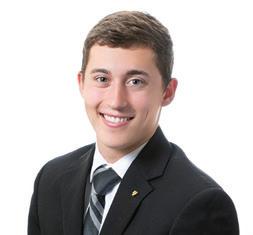
Cameron MacNabb: Hello and welcome to Emerging Grower, a podcast where we'll focus on bringing growers and ag tech professionals together to help accelerate conversations between the two fields and the agriculture industry. This podcast is energized by Grand Farm, which is enabling technology to feed the world by facilitating collaboration on innovation, solving some of the world's largest challenges in agriculture technology. My name is Cameron MacNabb and I'm a member of the Grand Farm team who is helping facilitate this podcast. Joining us in this month's episode, we have Jake Joraanstad and Paul McCrory discussing software technology and agriculture. Jake is the Co-Founder and CEO of Bushel, which has powered 1200+ grain facilities across the US and Canada with real-time business information for their producers. Paul is a student at NDSU studying agriculture economics. He grew up on a seventh-generation family farm overlooking the Missouri River. They grow mainly corn, soybeans, and sunflowers along with some feed crops. We hope you enjoy Jake and Paul's conversation and that you also are able to gain valuable insight into the world of agriculture.
Jake Joraanstad: Alright, hey everybody, my name is Jake Joraanstad. I am the co-founder and CEO at Bushel. We're a software company based in Fargo, North Dakota here, and I grew up in a family which farms on both sides of my family. We've been building Bushel since 2017 when we launched this product to the ag industry. Grain companies, co-ops and ethanol plants, are our customers and the farmers are our end users. And so that's kind of where I'm coming from



today in this conversation. And we have our friend Paul here. I'm going to have him share a little background on himself, his farm, and what he is up to in school. And we'll jump in.
Paul McCrory: Yeah, thanks Jake. So like you said, I'm Paul McCrory. I grew up in Linton, North Dakota. Just South of Bismarck, about an hour. I grew up on a farm just overlooking the Missouri River there. We have red Angus cattle as well as corn, soybeans and sunflowers are pretty much our main row crops. We have a little wheat as well and we do some feed crops to keep the cattle going throughout the winter. I have one older brother, he's two years older. He moved back to the farm. He's married and has one kid. Dad's still heavily involved in the farm and grandpa's on the farm as well. We've been there for seven generations, so sticking around a while. Currently, I'm in my third year here at NDSU. My major is agriculture economics. I'm looking to hopefully get into grad school as well, looking into agribusiness and applied economics with something probably in the commodity trading field.
Jake Joraanstad: Thanks for the background. So back to the family farm. Real quick before we jump into what you're doing at school, was it a farmstead, was it the homestead farm? How’d the farm start? Do you know the story? Seven generations must have been, you know, you guys must have moved in as a homestead situation
Jake Joraanstad Co-Founder and CEO, Bushel
Paul McCrory Agriculture Economics Student, NDSU
Cameron MacNabb Podcast Coordinator, Grand Farm
Photo by Hilary Ehlen
FUTUREFARMERMAG.COM 59
Jake Joraanstad & Paul Mccrory
Paul McCrory: Yeah, so I think that first generation that came over actually settled in a place called Winona. That'd be probably about 15 to 20 miles south of where we're currently at. And I know they did some trading across the river there. So, when it froze they did some trading there and had some good river bottom ground there that we actually still farm a little bit today. And then I think a generation after that moved up to where we're currently at and they would've been on the river bottom. And then when they flooded the Missouri River, my grandpa actually moved on top of the hill just to get away from the water. So he moved on top of the hill, got a little more land there and that's where our farm currently sits.
Jake Joraanstad: So cool. Lots of stories in North Dakota of homestead farms. It's always fun to understand. So tell us a little bit maybe about your grandpa first and then maybe what your dad's role is on the farm now. Start with your grandpa though.
Paul McCrory: Okay. Yeah, so Grandpa McCrory, Glen's his first name. He definitely liked the cattle a little bit more. We have some pretty good pasture land along the river there. You can always get water pretty easily and the farming maybe not be quite as good right around our farm just because the land's a little bit rougher. So he grew up a little bit more involved with the cattle. He was always involved in the water commission board too, in Linton. Stayed pretty involved with that just because being along the river there. I deal a lot with the Corps of Engineers and things like that. And then my dad went to NDSU as well. And then when he came back he slowly started taking over and started growing the farm.
He knew it pretty well and he got a little more into the farming side. So we still have those cattle like I mentioned before, but I'd say my dad's a little more focused on the grain and things like that. And then
my brother just came back recently, he always grew up liking the cattle a little bit more from my grandpa. He always encouraged that we got our little herd started when we were in middle school and high school. So my brother from there kind of grew it and he has been a little bit more in charge of that. It's been a little easier for him to take over. We built a lot of fences growing up, so we got some blood, sweat, and tears there. But I know he's always like that. And now he's getting a little more involved since he's back full-time.
Jake Joraanstad: So growing operation, certainly your dad is probably the one that grew it—maybe the most in the row crop side. Yep. Pretty decent cattle operation as well. Your brother's kind of in charge next probably as you're still finishing school out here. So tell us a little bit about how, you know, are you spending time in the spring and fall? Are you going back on weekends? What’s your normal life kind of living in Fargo out here, but being on the farm when you can?
Paul McCrory: Yeah, so I'd say after I graduated high school that summer I was really involved. Didn't have much for sports or anything, so that would've been one of the times when I got to know the operation the best. Anywhere from planting, helping dad spray and anything like that. And then coming to college, I didn't go back a whole lot just because I knew I wanted to be involved as much as I could in high school, and try and hang out as much as I could up here. Would go back a couple of weekends, definitely during harvest and I went back a little bit early to help plant as much as I could. Dad would kind of keep the planter full of seed, fertilizer, anything like that. And he knew I could maybe stay up a little bit later than him. So I would try to stay up as late as I could and keep everything going. And then after my freshman year, I went back and we actually were able to get some irrigation and that was the summer
that we had droughts. So it was pretty essential.
Jake Joraanstad: And it was good timing. That was the first year you had put irrigation on the operation, right?
Paul McCrory: Yeah, so we were actually given the opportunity to rent the land that the irrigation was on.
Jake Joraanstad: So you learned how important that was going to be during the drought? No, this year you're okay, right?
Paul McCrory: Yeah. We actually had some sunflowers on there and we didn't have to use it too much for those. So it's, it's definitely some older equipment that we don't want to use too much. But yeah, other than that we haven't gotten too involved in anything else. We just started potatoes a little bit this year, trading some land with the Cavendish farms.
Jake Joraanstad: Okay. So first year getting into fresh potatoes or are we talking about processed stuff?
Paul McCrory: Yeah, so it's all fresh potatoes. They pretty much just swap land with us. So they take the pivots that we have and we do some, because of the rotation, they don't want to deal with the corn or anything. They're pretty much just focused on the potatoes. So that's the kind of stuff we got into this year.
Jake Joraanstad: So, speaking of equipment, we have to ask the question, what color is the farm operations equipment?
Paul McCrory: Yep. We’ve got John Deere out of our farm.
Jake Joraanstad: Okay. All right. Green stuff.

60 JAN/FEB 2023
Paul McCrory: Oh, that's right.

Jake Joraanstad: RDO will be proud of you. The next question is the Bushel question. Who do you sell to?
Paul McCrory: Red Trail Energy is where most of our corn goes to. And then Lighthouse Commodities.
Jake Joraanstad: All right, so let's talk a little bit about technology. You're going to be for sure the youngest person on the farm when you're out there and maybe if you run it in the future with your brother. Your brother's a couple of years older than you, right?
Paul McCrory: Yep. He's two years older.
Jake Joraanstad: So, you and I were talking before starting here on the conversation. I think technology's both a battle and a benefit. Where are you seeing, you know, when you're just out there even this fall or something, where are you seeing the benefits? And then maybe talk a little bit about where the challenges are in your mind. And whether it's for you or maybe even talk about maybe how your dad views it. Certainly, grandpa probably likes to ignore that if he can at this point.
Paul McCrory: Yeah, it's definitely interesting to see the dynamics there on who accepts it more and who doesn't. And I've actually said my grandpa has been pretty open. He's kind of always been really open-minded to it. So this summer we actually got an app for him to run the irrigation on his phone. And he’s been pretty excited. So he can go up there.
"Lots of stories in North Dakota of homestead farms. It's always fun to understand."
FUTUREFARMERMAG.COM 61
-Jake Joraanstad
Jake Joraanstad & Paul Mccrory
Jake Joraanstad: Love that. He'll have to leave his chair to see what's going on.
Paul McCrory: That's right. Yeah. He can take a nap and then wake up and check the pivots and works pretty good. Call if there's ever something broke down.
Jake Joraanstad: That was a twohour job before checking pivots probably, you know, you have to go out and back again and whatever else. Now you can sit there and at least see what's going on.
Paul McCrory: Yeah. So we've been trying to upgrade the older technology there. Some are running on hydraulic, electric, and everything like that. So the first year when I ran it, we were just starting to put those systems on so I could see them from my phone. But we're pretty much having to go up there and do everything by hand. Where now we're starting to get it so we can turn them each and every way. It helps a lot for harvest too. You don't have to get out of that machine and turn it one way or the other. So cool. It saves a little time there.
Jake Joraanstad: Who's out there plugging stuff in? Is it you and your brother? Is it your dad going out there and getting the technology set up? Do you have service providers coming out and doing it? Who's setting up? Like you got the app set up for your grandfather, but that takes technology on the pivot too. How do you guys do that?
Paul McCrory: Yeah, so I'd say whenever we have any technology that we want to upgrade or anything, we'd always have the provider come out and put it on for us. So I know like when our system was updating, we'd always call them and have them put it on for us because we didn't really have too much experience with anything like that before. So we definitely always call them. So I was definitely learning as much as I could and trying to really relay that back to my dad and my brother. It was definitely
beneficial for them this summer because they were running it themselves.
Jake Joraanstad: So for us technology people, listening in what, you know, is it practical or sustainable that you've got to have the provider, the service provider, the facility, the guys building the equipment, coming out and doing this? Or do you see a day where either it's easy enough for your team, just you and your dad and your brothers to do it yourself? Or do you feel like you're going to put the hat on more often than not? What's your opinion on where it's going? Do you kind of expect that service now that you buy the equipment or what's your opinion on that?
Paul McCrory: I would definitely say there's always going to be a need for someone who's heavily involved in that technology. Because I know on the farm, like my dad, he's really busy. Maybe even day-to-day stuff, like telling the hired man that he needs to go pick up some bales somewhere or breakdowns, and for him to learn all that or even my brother can definitely be challenging. So I'd say we'd either have the provider come out for each specific idea, like either with the tractors or anything like that or if it's with the irrigation. But we could also maybe hire someone who'd specialize in an area like that. But I know for my brother and my dad to learn it all, it would be a lot.
Jake Joraanstad: Yeah, that's fair. So, how old are you Paul?
Paul McCrory: I'm 21. Just in my third year at college.
Jake Joraanstad: And I'm 32, so we're both, well I'm a millennial. I don't even know what you are.
Paul McCrory: Yeah. I guess I'm not even sure.
Jake Joraanstad: Gen Z.
Paul McCrory: Yeah, something like that.
Jake Joraanstad: Gen Z. Gen Z, that's right. All right. Gen Z. I'm an older middle millennial. So both of us have this view. The fact that you still think it's going to kind of be on the providers to be heavily involved in making sure the technology's out there and working is important. Because I think a lot of people think, hey, you know, deploy an app and everybody will use it. But when it comes to equipment and hardware and setups on the farm, it's not so simple. How's connectivity out west? Do you guys, you know, when you're out in the tractor, do you have a network, can you stream Netflix on the iPad still or do you guys have connectivity issues?

Paul McCrory: I would definitely say service has been a little bit of a problem and that's definitely limited how much technology we can use. I know we've been trying to use iPads and stuff to collect all the data when we're harvesting or planting or anything like that. Just because if you could get that data, it would help a lot. But I know there have been times where we've maybe just been at the end of the field messing with the iPad and dad's out there like we don't have time for that. So I know definitely one thing is getting better service, that would be one thing that helps.
Jake Joraanstad: I assume a cell network would be better, that would be what you need help with. You don't have wifi probably broad enough on the farm to make it work for you.
Paul McCrory: Yeah, that's correct. Cell service would definitely be one thing. And then I'd say there's always maybe just some technical difficulties where we wouldn't know what to do. And we don't want to take the time to call the provider. We just want to shut it off and get planted.
62 JAN/FEB 2023
Jake Joraanstad: Shut it off, unplug it and get in the tractor.
Paul McCrory: That's right.
Jake Joraanstad: Okay. This is a question from me being a technology guy in the space and trying to be helpful. What do you see, like what opinions do you think we need to hear in the AgTech space? People who are building software for farmers people who are building this equipment that needs to be hooked up to some technology platform. What do we need to hear that would be helpful? Like what, what could change for you or what are your strong opinions in this area?
Paul McCrory: Well, I know one thing for us, there's always been a lot of yield data collection and everything like that. Everyone wants us to get that into John Deere or whoever we bought the seed from. They're always wanting to collect that. And I know one thing we've maybe had problems with on our farm is maybe the combine isn't even calibrated right. Or something like that going into the field. So where the data is coming from maybe isn't the most accurate so then our data really isn't too relevant. And I know that's one thing, just keeping it real simple for us because we don't want to spend that extra time to get all that stuff ready when we're at the end of the field. This spring was a good example where we didn't have much time. Everything was really wet. We couldn't get into the field for a couple of weeks later than we wanted. So once we were out there, there was no time to mess with anything. I know our liquid fertilizer broke on one planter, we just kept going because we had to get that seed in the ground to make sure it wasn't too late. So I know keeping everything simple and making sure it is easy for us to use because we just don't want to spend any extra time on stuff like that.
Jake Joraanstad: Yeah. So reliability, uptime, all that matters a lot. So let's talk

a little bit about the financial side. So crop marketing, maybe start there. Who picks up the phone and sells the crop? Is your dad still running that show or is your brother doing it?
Paul McCrory: Yeah, I would say it's been mostly my dad. So the way I think we've done it in the past is we've pretty much all had kind of our own separate stuff. So right now I'd say for the cattle, I guess not commodities, but cattle I think would be about half and half my brother and my dad.
I'd say the cattle's about half and half, and grandpa still has a couple too. So my dad, I'd say they talk about it a lot on what they plan to do with marketing, but in the end it's always a decision on whoever owns the head.
And then when it comes to commodities, Like I said before, we do a lot of stuff through Lighthouse. So my dad would always keep us in the loop on what he planned on doing. But in the end, my brother, I know he's always making his own decisions. He's texting me a lot trying to learn what I'm hearing in class. So I know they talk a lot, but in the end I know they always make their own decisions.
Jake Joraanstad: Yeah, that makes sense. And I think just for those who are listening in Lighthouse Commodities, it's kind of a unique player because they, you know, aggregate and buy the crop from multiple farms and have it delivered to other facilities. They don't actually own the elevator itself. They’re a third party, but they probably are advising your dad on what they think about for how they should market the grain. Probably if he's listening to them, it's going better than in people who are just making it up on their own or end up in the fall cash price only. That's the biggest thing we hear in the AgTech space. Everybody in AgTech seems to think we're all better crop marketers than farmers because we won. Look at the history even go, wow, farmers sell their crop at the worst price
every year, which is typically in the fall. Yeah. Once in a while they get lucky and that's the best time of the year, but most of the time it's not. But I don't think it's that simple. So you know, in your case if your family, you know, working with Lighthouse who's given probably good advice throughout the year that makes some sense.
Paul McCrory: Yeah. And I know it always helps that they're always willing to line up the trucking and since it is important.
Jake Joraanstad: Yeah. Logistics, right?
Paul McCrory: Yeah. And that's a big part of it too, just because we're trying to haul our grain like 120 miles for red trail and if they just take a little commission off that we're willing to pay that just because lining up that stuff is a big headache. And one thing that my dad can just pay a little bit for and know that he doesn't have that on his plate and it's going to an ethanol facility.
Jake Joraanstad: So. Yeah. The thing that we always remind ourselves in this space though is to remember how much futures price moves every year. And these, you know, the last 10 years could be some pretty big swings. So on the logistics side, how many trucks do you guys have?
Paul McCrory: Right now we probably have four working trucks.
FUTUREFARMERMAG.COM 63
Jake Joraanstad & Paul Mccrory
Jake Joraanstad: Okay. So thinking about the challenge of logistics you know, in this case you're not even using your trucks, they're sending trucks to you. What’s your view on this idea of autonomous trucking? How do you drive a truck in the fall typically? Or have you?
Paul McCrory: I have before. Yep. Yep.
Jake Joraanstad: So what's your view on you know, one of the things Emerging Prairie is working on with Grand Farm is autonomous trucking, So the idea that even if it's a lead follow where you're driving one truck and then the other truck's completely driverless and you've got ability to bring two loads of grain just simply that's doubling the capacity. But imagine that truck that maybe even Lighthouse worked with you on, picks up that grain with nobody in it on the side of the field and heads to the facility. I mean, do you see that sooner or later? Is it just crazy? What's your opinion on that?
Paul McCrory: Yeah, definitely. I know I could definitely see that where maybe Lighthouse would bring their trucks because we have some bins in town that are on a pretty good road. We have a lot of space there. Focus maybe picking up from the bin a lot of times not in the field.
Jake Joraanstad: Yeah. It's a little bit less problematic.
Paul McCrory: Yeah, I definitely think it'd be a long time before anything in the field just because there are always challenges.
Jake Joraanstad: You have got to be there right when the combine's there ready to load out.
Paul McCrory: That’s right. But no, I definitely could see it working with longer hauls like that.
Yeah. No, I definitely say that would be an option in the future. I know I've even heard of it a little bit in class. They've been talking about trying to get some of those autonomous trucks going. So I definitely think that could be a potential. I'm not sure how it would work with liability and stuff like that if it crashes into someone, but I know that's kind of where things are going. Like maybe even autonomous grain carts in the field going from truck to combine or anything like that. And I definitely think that'd be helpful as less and less people know how to use all this technology in agriculture. We're definitely going to need those guys that can do it the best to spread out their workload.
Jake Joraanstad: Uber for trucking. We're going to figure this out someday. So my farm tech friends would be really upset if I didn't ask this question. What do you guys use for your accounting software? Do you know what your dad or your brother does for financials? Are you doing QuickBooks online? Are you doing spreadsheets and you've seen a lot of spreadsheets?
Paul McCrory: Yeah, so I would say my mom and dad actually both were accountants coming out of college. That helps. My mom actually runs an accounting firm in Linton.
Jake Joraanstad: Okay. And does she do the farm financials as well?
Paul McCrory: She does. Yep.
Jake Joraanstad: Okay. How about you Paul, any questions coming my way, what are you thinking about? What do you want to ask from a guy like me who's supposed to be building valuable tools for farmers?
Paul McCrory: Yeah. So maybe one thing, how did you guys come about the Bushel app?
Jake Joraanstad: Well, that's a relatively simple answer. My co-founder Ryan, you know, grew up on the farm every day. You know, I grew up near farms working on my family's farm once in a while. He grew up on the farm helping his dad deliver sugar beets, beans, and corn into the facility. And he remembers all this, you know, even more recently, all this time spent trying to keep track of scale tickets. And so that was, that delivery ticket or scale ticket was the first thing we wanted to solve for. He said, hey, it's pretty ridiculous that you have to drive through and get this paper receipt and then figure out how to get it back to the right organization back on the farm. And then that needs to get entered eventually into, you know, either keeping track of your own, you know, people are doing math on their own contracts.

And so how can we make it easy to see every delivery you're making, every contract that you have with that facility and then updating that stuff in real time. You know, you should be able to see your contract update today. It shouldn't be next week or in the mail or whatever. And so, so much of, well not the companies you're working with, but so much of the industry is paper and we started there, so how can we digitize all the paper processes? And then once we did that, we knew we could sign contracts on the app. Now you can submit offers so you're okay, you know, your data, your brother could go in and put a futures offer in and lock it in for the fall if you wanted. And now we're working on making payments available. So instead of, you've seen the paper checks stacked on the desk. So somebody's got to have you run them to the bank.
So you may need to drive just to put money in the bank. The rest of us get that in a bank account every couple of weeks with our paycheck. But farmers’ paychecks come in, paper check in the mail has to go to town. So that's something else we're working on is there's no reason your dad's got to do a
64 JAN/FEB 2023
20-mile round trip, 40-mile round trip, to drop a check off.
Paul McCrory: Cool. So maybe one thing is how you guys are advancing and it seems like you guys are advancing really quickly. What could we do as producers to help give you guys feedback that would accurately improve the technology you guys are already using?

Jake Joraanstad: Well, one of the things that's a really basic challenge is I think farmers think they're giving people feedback because they're at the coffee shop and they complain to their friend or whoever. Or you're out, you know, you're out at a football game and talking to somebody. But remember I think you have got to remember it and it's partially the technology company's fault too. But I may not be at the same football game that you're at. So I don't think that the industry is getting enough direct feedback from farmers and we may talk like we know the farmer really well, but unless you're out there riding around in the tractor or sitting in the truck and checking things out together, it's hard to get the raw real feedback.
But I would guess farmers assume that their feedback's gotten there because they get to talk to other people about it. But I think like, you know, John Deere corporate probably doesn't hear your dad's complaints directly about why that tractor wasn't doing its job. I think if we could figure out a better way to get that feedback directly it'd be awesome. In Bushel's case the customer is actually the co-op. Or the grain company. And then the farmer is the end user and it actually has their logo on it so you don't even necessarily know always that it's us.
Paul McCrory: Yeah. Unless it's powered by Bushel. Right at the bottom.
Jake Joraanstad: So we know that that would help. We build these user groups but it's hard to ask for farmers' time above and beyond what they're already doing. So that would be something that would help a lot is if we had, if everybody had a little more access to what the farmers thinking, I'm sure if we had a Facebook poll we'd get all kinds of opinions, you know, but that's probably a gap in my opinion. I still feel like we don't get enough feedback from the farmers.
Paul McCrory: Yeah, no and I can definitely see it being very helpful even if you just sent someone in the combine, because that may be when we have time. Yeah. And ride along. That's where you're going to get the most information.
Jake Joraanstad: And that's the best time.
Paul McCrory: Exactly. Yeah. Yeah, no one wants to get out of the combine.
Jake Joraanstad: Yeah, good point. Maybe we just all have to get in the field and hang out when you guys are doing that. We don't want to be in the way either. So. Cool. Well Paul, thanks for joining, and looking forward to more conversations.
Paul McCrory: Good to meet you. Yeah. Appreciate it Jake.
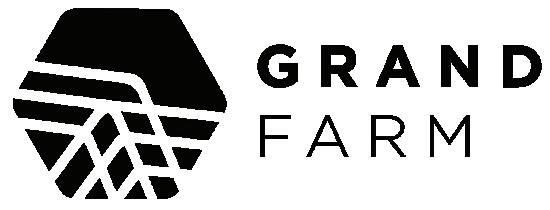
TO LEARN MORE ABOUT GRAND FARM, YOU CAN VISIT THE WEBSITE, WHICH IS WWW.GRANDFARM.COM. FUTUREFARMERMAG.COM 65
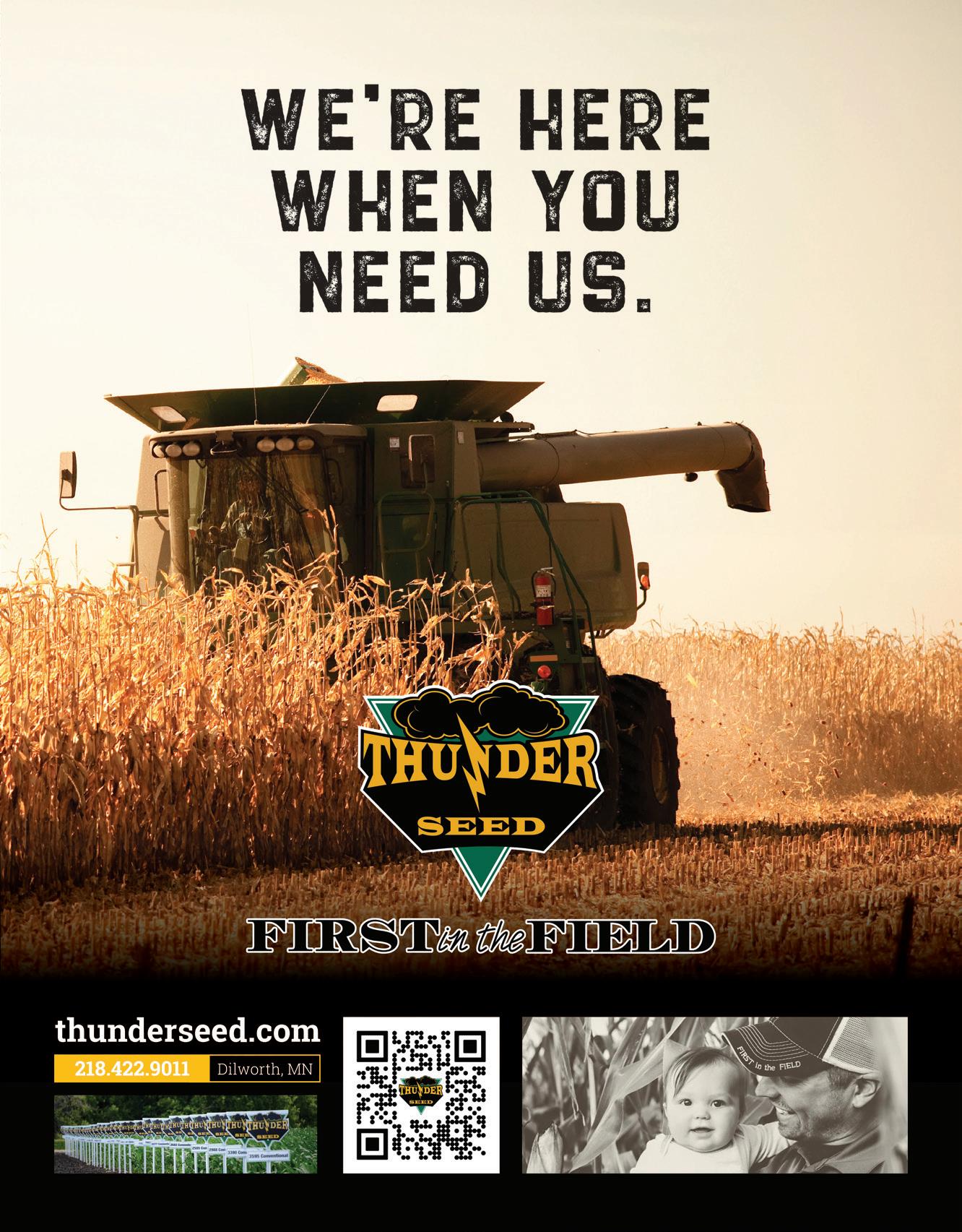









































 MIKE BRADY KIM
LEVI TY
GENEVA
GRANT
SAM JOSIAH
GARY
PAUL
DEVAN TORI
KACEY HAILEY
MIRANDA
JESSICA
NICK KELLEN
BEN TOMMY KELLAN
JONATHAN
MIKE BRADY KIM
LEVI TY
GENEVA
GRANT
SAM JOSIAH
GARY
PAUL
DEVAN TORI
KACEY HAILEY
MIRANDA
JESSICA
NICK KELLEN
BEN TOMMY KELLAN
JONATHAN

 BY GARY USSERY
BY GARY USSERY





 Photos provided by Emerging Prairie
Photos provided by Emerging Prairie
















 Photos provided by Emerging Prairie
Photos provided by Emerging Prairie


















 Photos provided by NASA
Photos provided by NASA





















































 By Sam Kise
By Sam Kise




















































 by Pam Dawling
by Pam Dawling





















 Ron Holiday stands on the far right among an important cast of characters.
Ron Holiday stands on the far right among an important cast of characters.






